Abstract
Research Question: How does Shell manage diversity in its workforce and how that management is useful for sustainable business and accelerating the growth of the company?
The discussion and analysis in this paper are regarding diversity management activities and their effect on the activities of Shell. As the diversity due to the presence of the company all over the world is a compulsion, the exploration of the ways, the company uses it to sustainable growth and business is present. The reason for the research regarding diversity in this paper is to know how it is helping the company to grow.
For that purpose, a researcher used relevant content from the website of Shell, academic journals, and books about diversity. In addition to that, there is a questionnaire to interview 20 employees belonging to different departments of Shell in Nigeria as part of the methodology to find the effect of various types of diversity on the company. The answers to the questionnaire found support in authentic academic sources regarding diversity management.
It was found that the way the company appeases the locals who are against the company and makes them favorable finds a place as part of the diversity management of the company. The interview results are in the form of appendices and are analyzed and evaluated according to the previous research results in the context of a Multi-National Company like Shell.
Introduction
- Research Question: How does Shell manage diversity in its workforce and how that management is useful for sustainable business and accelerating the growth of the company?
- Aims: To know the relationship between diversity management and sustainable business growth of Shell is the fundamental objective of the research. How can Shell use the diversity for growth and sustainability of Business?
- Objectives: To find out the ways and means through which, Shell manages diversity across the company according to necessity. Do the ways and means found are suitable to a company like Shell to manage diversity according to the needs of the company.
As a result, the discussion, analysis, and evaluation in this paper are regarding management policies and strategies in Shell related to international business activities. As Shell is operating in several countries, the examination and discussion in this paper are regarding diversity and cultural differences, the company is facing as well as the problems that exist in the country in which the company is operating. In this course of analysis and evaluation, the way Shell evolved into this shape is part of the discussion and the policies are analyzed as well as evaluated accordingly. While analyzing the evolution of Shell and its policies, the dissertation presents the discussion and analysis regarding the volatility of the present business environment as well as the diverse nature of the geographical areas.
The foremost aspect in argument regarding management is about involving the regional head offices with the activities of global head quarters. In the above context, the strategic management of the culture in different geographical areas will find place in analysis. In the course of above discussion and analysis, naturally, the role of regional head office finds place and the evaluation follows. The consideration in analysis is the way the company intervenes for providing information as well as getting it in the form of capital resource provider and as top management.
The decision of the management to use country offices as the ones to collect specific information is analysed and the evaluation of results is in the form of responses 20 employees in various divisions of the company in Nigeria. After that, the way the company uses the information provided by the country and regional offices finds place in analysis and based on that evaluation takes place.
In the course of analysis about the way, the company uses the information provided by the country offices; the role of the offices in different countries as well as regional offices is part of examination as well as evaluation. The above-mentioned context enabled the researcher to argue and analyse the diversity and its management in the company over various geographical areas have helped the company to maintain growth. In the above analysis, researcher’s view is that the first hand information about the culture of the area is important and the analysis regarding decision as well as planning and implementing the specific programs is in relation with that.
Hence, in the above context the freehand given to the regional and country heads to develop business, is part of the analysis and viewpoint of research and argument is to review the management and results of environmental scanning practices (Chittipa Ngamkroeckjoti, Lalit M. Johri, 2000).1
In the course of research and analysis for this paper, researcher’s view is that the sustainable strategy is important for a company like Shell. Hence, the examination of sustainable strategies of the company according to diversity in the company find place in discussion and are supported by analysis and evaluation in the dissertation. The dissertation considers Supreme Petrochemical Limited’s quotes about sustainable strategies of Shell in India that involves diversity management and finds how the company is using diversity for sustainability. The significant argument in the dissertation is regarding importance given by Shell in developing strategic relationships in emerging markets like India.
After the discussion part, the argument supporting sustainable strategies observed by the company in the time of crisis as well as in boom period finds place in analysis. The consideration of the activities of the company in Mumbai, India to make the local people to participate in the activities of the company as well as to benefit from it finds place in discussion regarding involvement of local people and the researcher’s argument is to support it.
Hence, the activities regarding that concept found place in the paper as part of observing the sustainable strategies of the company. Consequently, the analysis and argument in the dissertation is about affect of sustainable strategies on the management activities that develop the business by enhancing sales and production.
In this context, the researcher considers the view of N.Gopal executive director of Shell in India that emphasises the role of local people in the sustainability and development of business as well as smooth developing of operations to support the argument. Hence, the examination of facilities and opportunities provided by the company to local people and the way they are useful in enabling the company to manage the subsidiaries in different geographical locations finds place in the dissertation (SPL, 2008).2
In addition to the above-mentioned activities, the examination of development of strategies to remove or use waste streams supports the argument regarding company’s sustainable development activities. In the above context, the way in which Shell tries remove the impurities from the products and the importance given by the company to degrade them is observed in the dissertation. Hence, the company’s waste management strategies found place in the paper as part of sustainable strategies. Moreover, the paper examines whether the company has any plans to reduce the waste disposal volume. In this context, the argument is about attractive and innovative solutions of the company for waste management and reduction as well as sustainable strategies (SPL, 2008).3
In addition to sustainable strategies of the company, the activities of the company that enables the socio-economic development of geographical areas it operates are part of the analysis and how the company uses the Micro, Small and Medium Enterprises (MSMES) for its development finds a place in argument that supports management activities of the company. The researcher observed that the company encourages the entrepreneurial activities to harness the benefits from natural resources, the way it utilises them to the growth of the company as part of the paper. The examination of the methods, which Shell uses to empower the local communities to gain their support, is present.
This inclusion of the above aspect is to support the argument regarding management’s strategies that use information from country and regional offices. Hence, the above context finds place in paper to analyse the way the company uses the information from country and regional offices.
In the next stage, the engagement of company in development of local communities by revolving loans, credit guarantee schemes, partnership, training and capacity building, the way they are useful for the company is part of the discussion as well as analysis (Shell Nigeria, 2008).4
In addition to the above concepts, researcher focussed in environmental aspects of shell also and argued that the social responsibility of Shell in doing business helped its expansion to different geographical locations. The exploration of Shell’s energy efficiency measures by interview with its CEO Jereon Van der Veer regarding technologies that reduce CO2 emissions in their production process is present. Hence, the processes and technologies of Shell involved in making lubricants that are more efficient and fuels are explored in the paper. Moreover, researcher found answers for questions like reconciling the need for emission reductions with Shell business strategy from interview of Cramor with Jeroen Van der Veer (Jeroen Van der Veer, 2007).5
In the context of cultural diversity, the analysis is about the activities of the company with speeches and documents from website of Shell regarding cultural diversity and the study of implementation is present. However, the utilisation of cultural diversity also finds place in the paper. The next step is HR strategies combined with cultural diversity, in which analysis is about framing of HR strategies according to implementation of cultural diversity and equal opportunity.
In this context, the exploration of nature of active HRM in Shell can be found along with the way the company uses that type of strategies according to job market, task technology, laws, societal values and market conditions. After the discussion of societal values and job market, the functional flexibility HRM that maximises the contribution of employees in increasing the organisational capability has been explored using some academic sources and finding how it is suitable for Shell.
In the important part of the literature review, the academic, authentic and documents from Shell websites are reviewed. The issues like training, gathering of information and maintenance of diversity in training batches finds place in the review. The points observed in the review are useful in further analysis and discussion. After training strategies, the review is about the transfer of capital and information. The reason is to examine how HRM find effective transfer of capital and information from top to bottom and vice versa.
After the above-mentioned aspect, role of top executives in managing cultural diversity finds place in literature review. The review is about the way top management finds methods to manage the diversity. Hence, as continuity to above concept the extent of diversity in recruitment finds examination by quoting the speech by John Jefferson, cultural director of Shell. The words of John Jefferson further prompt the researcher to review the usage of diversity in work force to face the competition in different geographical areas. Consequently, the further review makes it possible to explore the reasons for the diversity.
In the next stage, the cultural policy finds place in review as the researcher observes the connection between policy and analysis. As the company finds the diversity in its market place as it is operating in different geographical locations, the review contains diversity in global market place. In the above review, the researcher cites the authors who emphasizes on diversity in work force of global firms like Shell.
After literature review, methodology lays down the guidelines for research and analysis of the diversity management in Shell as well as its activities regarding management and sustainable strategies. One can find in methodology the empirical data collected and the number of employees interviewed for questionnaire prepared by researcher. After that, the questionnaire finds place at the end of methodology. The questionnaire contains answers also obtained from 20 employees of Shell in Nigeria.
After that the discussion as well as analysis starts according to the points in literature review as well as the answers in the questionnaire. After the initial discussion of diversity and other activities of the company, the analysis regarding the implementation of law and diversity finds place in the form of responses from employees as well as the policies of the company. As part of the analysis, the emphasis is on societal values followed by Shell as well as the evaluation of their effect.
The next part of the analysis is about political affiliations of the company in the countries in which it is operating apart from maintaining diversity of different aspects. The discussion focuses on the benefits for the company for right political affiliations and the ways it follows to do it.
As continuity of the above discussion, the researcher makes a separate chapter that analyses the effect of cultural diversity. In this context, the diversity regarding nationality also comes to the fore and the effect of it on the activities of the company finds place is discussion. After that, the next chapter in discussion and analysis part is effect of diversity on organisational change as diversity is affecting productivity as well as other activities. The manner in which employees learn from diversity is evaluated in this part and the role of diversity in organisational change is emphasised. In this course of discussion, the importance of diversity in top management finds emphasis to manage diversity and the organisational change due to it.
However, as marketing is important and end activity of any organisation, the effect of different types of diversity on marketing strategies finds place in discussion. In the course of discussion, the importance of age diversity is emphasised and the mention of the role of it on organisational change arises. Consequently, the role of local employees in marketing strategies of the company is analysed to emphasise the importance of local people in marketing activities and strategies. As part of the emphasis of the importance of locals, the expenditure of the company for empowerment of blacks in South Africa is mentioned to reveal the importance the company gives to the relations with locals and their businesses.
Cultural Diversity in Shell
In this chapter just after introduction, the explanation and evaluation on the way sustainable strategies go along with diversity in shell can be found. In this regard, the quotes from the speech of Rob Routs in 2007 at EPCA annual meeting in which he states that Shell has found energy in diversity. He states that he found innovation and diversity in Shell’s exploration history for 35 years from Chemical Engineer to Executive director.
He states that the creation of Royal Dutch Shell 100 years ago was a unique act of diversity and inclusion and remained crucial for success of Shell. He states that the expression of diversity is present in evolution as well as formation of Shell. Royal Dutch Petroleum and Shell Transport; a Dutch Company and a British Company merged their interests to retain their separate identities. Hence, in that way, Royal Dutch Shell has undertaken a diversified act to face global competition as massive scale and resources are necessary to compete in new economic arena.
He states that from the moment it formed, the organisation has built up a diverse workforce with an inclusive philosophy to develop and market petroleum products around the world. As the company makes moves and sells petroleum-based products like fuels, lubricants and chemicals, it is necessary to work internationally in challenging environments. In the earlier days, international staff used to move from one expatriate assignment to another.
However, the focus on diversity by the company has developed local staff for the assignments, which expatriates used to do in the past. Hence, the diversity management resulted in developing international mindset in the people with whom the company is recruiting or working with. He quotes the step in 1990s that has taken the diversity to next level to have greater advantage of human energy to meet fiercer global competition. The company used the diversity to have the best ideas from around the world as it is important than ever for the company like Shell. As a result, Rob Routs informs that it led to greater work across national and cultural borders (Rob Routs, 2007). 6
Recruitment Processes and Diversity in Culture
As part of activities around the world, in 2007 Shell targeted its 6,000 senior managers to participate in gender awareness session to remove barriers for retention and progression of women. Hence, the organisational culture of Shell resulted in cultural as well as gender diversity. This step reduced the number of expatriates in Shell, because of diversified workforce in senior management cadres.
As part of the diversity management, Rob Routs mentions the vision of a globally diverse workforce and the role of Asian Talent Council in it, which is a cross business and cross country body comprises of Shell’s key business and functional leaders in Asia. The Asian Talent Council supports the growth by accelerating the quality and standards of Asian people in leadership positions. In addition to above-mentioned activity, Shell is adding external assessment to its performance to strengthen relationships with Universities to engage new employees from interns to seasoned professionals (Rob Routs, 2007).7
Principles and Practice
In the above context of diversity, it is important to learn about the principles and aspirations of the company as well as its practice of them. Hence, to know about the principles of the company as well as its aspirations, it is important to know about responsibility and practice of the company and they can be will explained by senior staff at Shell. In this context, one can use Adrian Loader’s speech in 2004 to know about organisational culture.
Loader mentions about social responsibility as part of organisational culture and states that it has been a way of conducting business in Shell. This resulted in setting highest standards of behaviour that value employees and creates sustainable business that delivers value for company’s shareholders. Loader emphasises that the social responsibility of the company never affected negatively the benefits of shareholders as the company made it a part of business.
The activities of the company are in such a manner that reduce the business risk and allows creating sustainable business. Loader also talks about developing countries in Asia. He states that Shell has developed business in socially and environmentally responsible way. He explains that the company conducts business in a way that avoids hostile public reaction from the local public, as it is important for sustenance and existence of the company in the area in future. In this context, he quotes the public criticism in company’s activities in Nigeria regarding the Brent Spar Oil installation, which has been decommissioned.
Shell used this experience to make corporate social responsibility as part of the business to avoid hostile reactions from the local public as it is crucial for the continuity of existing activities as well as commissioning of new installations. Hence, the way and practice of business at Shell is to operate the business in a way that avoids a hostile reaction from local public and social responsibility is a tool for that type of practice. Hence, according to above discussion the organisational culture at Shell is a combination of diversity with inclusiveness and doing business with social responsibility (Adrian Loader, 2004).8
In addition to above aspects, Shell promotes diversity throughout a business by encouraging employees to value their colleagues in the diversified work force. The above aspect helps in retaining the work force as well as its diversity (Jeremy Tipper, 2004).9
HR Strategies and Cultural Diversity
As Shell is promoting diversity in different geographical locations, the HR strategies and cultural diversity are important. Hence, in this chapter the importance of HR strategies that promote cultural diversity finds emphasis in discussion. The discussion is regarding the sustenance of above-mentioned activities that result in maintenance of cultural diversity in Shell as well as the overarching HR strategies, which are necessary to maintain diversity in culture of a global company.
Consequently, the diversity in culture should give an advantage regarding human resources as employing better people in organisations with better process through diversity results in better business and marketing. The aim of the company is to introduce a system that is capable of complementing the business and reflects the way to treat customers as well as the employees. The company tries to give the right training in right sort of culture and helps them to deliver in the diversified atmospheres in the globalised business. Hence, if the diversity of culture reflects in recruitment as well as the strategies of the company it can operate successfully in diversified business atmospheres (Armstrong, Michael (Author). 2006, page 108-116).10
Importance and Usage of Cultural Diversity
The importance and usage of cultural diversity lies in the context of increasingly outsourcing of the operations of a company across the globe and the essential training necessary for the staff spread over different cultures. The communication across the cultural diversity in a company makes the managers to understand the importance of human relationships in different cultures and that enables them to discover the impersonal communications can back fire.
The knowledge gained by management in training diversified staff can be helpful in making marketing strategies in different cultures, as different strategies are necessary for different cultures. The people from different cultures in the course of interaction in their training give valuable inputs to the management that is useful in developing human resource strategies as well as advertising and marketing strategies. Moreover, the diversified workforce in the company helps in developing virtual team and avoids the feeling that the managers are talking to a machine and gives a lively impression about the interaction.
It is because different cultures enable the managers to develop communication skills continuously and that avoids even monotony in the communication. The above aspect helps the company to keep the managers as well as executives creative all over the world and enables to keep the connections between head quarter and regional offices as well as country offices continuous to update the strategies whenever there is a need (The Richardson Company, 2002).11
Nature of Active HRM in Shell
The nature of HRM in any company depends on situational factors like job market, unions, task technology, laws, societal values and market conditions. In addition to that, the work force characteristics and business strategies are also important and they depend on management philosophy. In the above aspects, the societal values, business strategy, workforce characteristics and management philosophy depend on the culture of the area the company in which it is operating.
As Shell takes into consideration the culture as well as the diversity in HRM according to culture, the company’s societal values, market conditions, workforce characteristics, and business strategy and management philosophy to frame strategies are according to Principles of Human Resources Management by Alan Price. Alan Price (2000) states that the above activities reflect cultural diversity that promotes the business as well as the development of human resources.
The nature of active HRM in Shell thus ensures wellbeing of the workforce according to the society the company is operating. Moreover, the long-term consequences of the maintenance of diversity and active HRM result in organisational effectiveness and individual well-being that enables the retention of the employees. Shell maintains the multiple stakeholder models in human relations tradition with help of diversity in the workforce. The development of interests of employees along with other stakeholders like shareholders and management, the flows of human resource and reward systems are necessary.
The above aspects increase positive employee influence on the operations and work systems. Moreover, performance management is a key for management of Shell and the company considers it as a wide-ranging process. As employees as well as managers dislike appraisals, according to Alan Price, the general suggestion is that the company can have psychologists as managers who manage appraisal forms.
The above aspect ensures the fine judgment on personality traits and personal qualities of the employees. However, Shell can use the appraisal forms that enable the employees to add their own remarks and thus offer an extra advantage for employees and prompt the managers to appraise correctly about the employee as well as the workplace environment. An important aspect that is necessary for a company like Shell is measurement of behaviour in their human resource management. It is possible by behaviourally anchored rating scales. Instead of making judgments of better or worse performance, a list of occurrence of specific behaviours in a particular period and helps the management to pick out the sincere executives in the workforce (Alan Price, 2000).12
Functional Flexibility in Active HRM of Shell
The aspect of functional flexibility is regarding initial implementation. The policy of HRM should be in a manner to make the people be embedded in the organisation’s work culture. Clare Lelliher, Michael Riley (2002), quotes Ulrich and Lake (1990) about organisational capability in maximising the contribution of employees in achieving organisational capability. Hence, in the above-mentioned aspect, the new way of thinking in managing people comes to the fore and external coherence is necessary for the HRM of a global company like Shell as its workforce is diversified as well as its work locations.
In the above context, the full integration of human resource management is necessary to make it a part of strategic planning. Thus, the organisation can make HRM policies being coherent with policy areas and across hierarchies. The above aspect in the companies like Shell is capable of maximising employees’ contribution to the organisation. The employees’ contribution can be maximised by internal coherence between policies and employees.
The reason is that the understanding of the policies by employees enables them to work in more productive manner instead of working on duty basis. In the above context, the active HRM policy can avoid the negative reaction from employees as the employees have coherence with the policies and goals of the company and rewards for achieving them. In the above context, the implications for managers are beneficial as the model is flexible in management of labour.
While managing the diverse work force according to active and functional HRM, the numerical functional flexibility allows the supply and demand for labour to be matched more closely. The identification of ‘humanisation of work’ approach is important in diversified workforce as humanity is same in every culture and in turn, that enables the easy advance of the operations. In addition to that, the global company like Shell needs to avoid the indulgence of employees in tasks that affects their efficiency. Avoidance of repetition is such a task that gives an opportunity to learn new skills and in addition to that, the job security in a company helps for the retention of talent.
However, Kolliher and Riley (2002) quotes Cordery et al. (1993) about the feeling of insecurity in employees due to changes to job design brought out by functional flexibility. This may be due to stress on employees due to overwork and lack of stability in nature of work regarding short-term deployments. In this condition, Shell considers stabilisation of work for the employees thus minimising the short-term deployments resulting in stability as well as suitable work culture that promotes productivity with quality. However, in the above condition of adjustment in functional flexibility it is important that a flexible employee should be responsible for taking responsibility of a group.
However, there is a problem regarding the benefits of customers as they are negatively affected by minimising the short-term deployment of staff. The above condition can be managed by ‘Shell’ as it does business on huge scales on global scale and thus the minimisation of short-term deployment can be neutralised by the benefits of doing business on large scale. Hence, in the above condition the diversified workforce, the active HRM and benefits of the customers are interrelated resulting in an innovative management of diversified workforce in a global company (Clare Lelliher, Michael Riley, 2002). 13
Active HRM in Attracting Right People
As mentioned above the innovative management of HR is interrelated to customer benefits, the active HRM can be used to minimise high attrition rates in a global company as other companies try to attract them as they are well trained and skilled. Hence, the essence of active HRM is rethinking conventional recruitment strategies. According to Kenneth Soh, GM of HR at Shell Eastern Petroleum, it is inevitable for global organisations to deliver compelling employees their value proposition in order to retain them. In the above aspect, Shell enjoys a reasonable reputation in retaining employees.
As the company is having a reputation of leading employer, it is being utilised to full extent and that too is based on policies as an organisation and employer along with the working personalities. Despite having a good reputation as a top employer, the management of Shell remains pro active with active HRM policies that acknowledge the right people for work as well as the branding of the company. The next part in the active HRM policies is to innovate and impress the employees as well as the customers. Thus, they do not support the combination of being strong employer and old recruitment policies and Shell does not do so.
The company has to develop relationship marketing to create different ways of resourcing through establishing talent pools that are difficult to attract and retain. Attracting mid-career recruits is as important as attracting early ones and that needs agile resourcing. As the company is a global one, it has the advantage of using experience of the older ones and enthusiasm of the early employees. Hence, a combination of experience and enthusiasm can be an important condition for agile resourcing.
Hence, it is important for a company like Shell to induct insight of the company into the recruiting agencies also. In order to do that it is important for the company to run a business management course as it is capable of attracting new talent to the company.
However, in the above course of recruitment strategies, the company has to follow as strategy that enables the management to recruit the best. This needs cognitive effort to recruitment practices and one such practice is to invite top personalities in the field in which the company is doing business. Though the active HRM is pro active, there should not be quick fix of the employees, promotion of desirable work place culture should be important, and it should be injected into the mind of the employee before the company recruits him/her.
Literature Review
The literature review in this dissertation, reviews all the aspects regarding management of diversity of all types. In the first step, it reviews the recruitment in two and three tier cities in different geographical locations. The next stage is regarding training strategies for a diversified workforce. This requires transfer of capital as well as knowledge and that too finds place in this review. As the above aspect needs the role of top executives, that too is part of the review to compare diversity and competitive environments. After that when the recruitment is complete, the strategies connecting diversity and improvement is part of the review. At last, the relationship between global market place and diversity is explored.
According to Samik Chatterjee, (2007), the important aspect in recruiting is to concentrate on tier-tier-II and I cities of country in which the company operates. The author opines that the hiring standards may be inconsistent in the backdrop of widespread geographical footprint if there are no strategies regarding active HRM. Hence, the above-mentioned innovative tactics are necessary for effective results in active HRM.
However, after hiring from different backgrounds and cultures in different geographical locations it is important to cater the needs of training for a diverse workforce. In the context of training a diverse workforce, every training room is a unique one. Samik Chatterjee (2007) quotes about the trainer having age diversity in the training room that acts as enabler and disabler. The training strategies make the age diversity as an enabler by making interaction between different age groups possible. However, there should be strategies for older trainees that make them learn and adapt to the new atmosphere and strategies according to the geographical location and culture. Moreover, it is difficult to mitigate the ego of senior employees, as they have to take training alongside with fresh graduates.
However, that ego can be mitigated by using senior trainees to lead the teams or groups that are formed in the course of training. Samik Chatterjee talks about the fact regarding the managing diversity in a global company, which starts with the trainer and training. The managing of diversity in culture needs a well-equipped trainer who knows about the ethnic diversities. The first step in managing diversity is to have a frank interaction with the trainees to make them move freely between colleagues of different cultures. Another significant aspect in coping with diversity is regarding socio-economic background.
The training should be open to employees of all lifestyles and of varied socio economic backgrounds. In this context, the trainers should take care of the cultural shocks the trainees from lower middle class undergo and should encourage them to participate in class activities. This act in training helps them to manage the diversity they face in future in work place as well as the area of marketing and production. Hence, the interpersonal interaction plays a key role in managing diversity in training thus making it easier in the future job activities of the employees. The other important activity that manages the diversity is the teamwork and this can tackle even the gender diversity.
The development of relationships between the trainees lays the foundation for managing diversity in future. The above aspect of relationships regarding office activities between trainees makes them to understand the difference in male and female styles of communication as well as working. Hence, the training that develops working as well as communication relationships between opposite genders and different cultures makes a team that manages diversity with professional ethics. The utmost important diversity that needs good management is regarding diversity of skills, levels as people of different cultures have different skills, and they have different levels of skills in different areas of working.
Hence, the trainer should make them skilled in the area they are suitable and have to make them aware of it. For example, the trainees of a particular culture may be good in communication skills and the trainees of another culture may be good in technical skills. The trainer has to recognise those skills and have to develop them accordingly as well as enabling them to communicate between them as they can use each other productively while working for the company.
As the bulk of the business is regarding petroleum products, the trainees should gain knowledge about all cultures as the products have market all over the world. As the expression of intellect is different in fields by the people of various cultures, it is important for a training strategy to pin point the area in which the trainee is expressing his/her intellect up to a maximum extent. This makes the management of diversity easier as they can understand and act according to the culture of the area they work.
Hence, the diverse participants in a training room and making them to manage all types of diversities enable the company to make them manage diversity of culture according to geographical area they work. Building of cohesiveness with other employees results in teamwork and Samik Chatterjee quotes the same and opines that the foundation of developing interaction between diverse people in training is capable of managing diversity while working in actual circumstances.
However, now then a little empathy is the need of the hour for the people who are not able to adjust to the culture fast and in this context; the other people in the workforce should understand that uniqueness of an individual is important as well. The above aspect makes to build effective interpersonal interactions while working and that is important to minimise the effects of ego and to maximise the management of diversity (Samik Chatterjee, 2007).14
Training and Strategies
As part of the Strategies, the global company like Shell has to work in different demographic areas it important to have a multicultural background in workforce as well as in trainers. The business landscape comprising of different countries that have different types of population and cultures is forces the company to have different training strategies that enable to implement marketing as well as the sales strategies successfully.
According to Patrick Schmidt (2004), the understanding of diversity plays a key role in training of workforce as well as other strategies of the company. Normally for a global company like Shell, the diversity is regarding race, colour, gender, age, nationality, religion, political affiliation, sexual orientation etc. Hence, the author talks about the dramatic changes that are forcing companies to accept the diverse workforce when they working worldwide.
According to the opinion and observation of Schmidt, the diverse workforce operates very differently than a homogenous work force as it can handle different cultural groups and that requires trainers who have diverse knowledge of different cultures or at least understanding the people of various cultures. In the wake of working in different cultures, the foremost aspect for the success of any strategy is to maintain and adjust to the diversity. Another most important aspect stressed by Schmidt is that the diversity in customer base forces the diversity in workforce, as it is natural that the customers tend to listen to the marketing strategists, when they find people of their own culture in the company.
In addition to that, the management of diversity needs respect for different cultures and the strategies regarding training also have to do so to make success the strategies of production as well as marketing and sales a success in the future by the people who are taking training now. Moreover, Schmidt talks about the diversity as multi-planed one as it comprises of both majorities and minorities and that definition differ from country to country as majority in one country may be a minority in another. Hence, treating them as par with each other and maintaining a strategy that honours minorities in training room or in the field is important to gain from their talent.
The training should cater to the needs of the company as well as the needs of the trainees as they can be retained when their necessities are taken care of. Another important aspect the global company like Shell has to deal is diversity regarding family background. Presently, there are number of single parent families as well as single member families and these results in different emotions for different people. Hence, the company has to make their strategies that do not hurt the emotional attitude of the employees as well as making the employee to avoid the negative impact on work due to emotional gap.
The company should be aware of the social, marketing and financial implications and can use this information in training to make the workforce an able entity in the company. The author talks about the increase of market for a company with the change of time and the same is true for the company like Shell as the consumption of petro products also increased in the course of time. This offers a diverse retail market and the management can use the diversity in the workforce to frame strategies regarding production and marketing and that should be reflected in training. Hence, it is necessary to take into consideration the diverse needs of people belonging to different cultures.
As the author describes the generation as the one, which have the people who spend more and economically also, the petro products of the company should concentrate on all the people thus acting according to the needs of consumer. The training programs should make sink this feeling into the trainees. The foremost important thing in training is to inject the feeling of diversity into the trainees and workforce and thus making them to feel as part of the company by valuing them.
Valuing the employees starts from the day of training as that involves communication and interaction. It can be understood that attaining a reputation of excellence depends on political correctness thus understanding diversity training as the one that is done for moral and social reasons. One may wonder about the benefits for the company that follows moral and social reasons. The benefits arise from the fact that the company finds its activities going smooth due to the presence of social coherence between its workforce and the people in the area it markets the products (Patrick Schmidt, 2004, Page 148-152). 15
Transfer of Capital and Knowledge
Wenchuan Liu (2004) quotes about multinational corporations as powerful vehicles that transfer capital as well as managerial and technical knowledge along with production functions. Even the marketing is part of that transfer. In the above context, the HRM is important as it provides ability for effective transfer of the needful activities. The author quotes about the competitive capability, which can be achieved by diversity in the work force.
The subsidiaries of an MNC like Shell face diversity as an obstacle also when coming to their subsidiaries selecting the HRM practices. They face diversity, as the HRM practices are different from those of the parent company when compared to those of the locally designed practices. However, to manage diversity in workforce as well as in the market conditions, the MNC like Shell need to adopt HRM practices that reflect the local environments and are connected to parent company. In addition to that the company has to transfer successful HRM practices to the subsidiaries and as a result a mix of practices that contain locally designed as well as the ones transferred from the parent company help to manage diversity as workforce find both the practices helpful.
This is because they find it easy to interact with the management using the practices of HRM find transfer from the parent company and find it easy to interact with locals and customers with locally designed HRM practices. However, Wenchuan Liu quotes Fenton-‘Creevy (2003) about the circumstances that influence the transfer of practices. In the present context of the paper, diversity is important aspect that influences the transfer of HRM practices. Hence, to combine locally designed HRM practices with those of Head Office, it is important to create transfer mechanisms in the organisation. One of the important aspects of transfer mechanism is to convince the workforce for the transfer HRM practices from Head Office.
The important way to convince the workforce is to adopt some of the locally designed HRM practices from the country office to the Head Office and that can be termed as an important aspect in managing diversity as it is important to have diversity even in the top-level managerial staff in the head quarters. While considering the management of diversity Wenchuan Liu talks about the acceptance of human behaviour and quotes Beechler and Yang (1994), Flood et al., (2003) and Hennart and Larimo (1998) regarding the effects of diversity and national environments. In this context, the author talks about the characterising of national environments in order to manage diversity in culture of the country in which the company is operating.
The extent of dissimilarity should be estimated and in this context, Winchuan quotes Kostava (1997, 1999) and Scott (1995). As that estimation refers to dissimilarity between home and home institutions, it provides an alternative explanation also. Hence, to estimate diversity the cultural and institutional distance offers comprehensive assessment of national environment in which the company is operating. Hence, according to Winchuan the important factors, which are mentioned as dimensions by him are, power, distance, uncertainty avoidance, individualism, masculinity and dynamism as well as social responsibility.
In this context, Winchuan remembers the research of Hofstede, which faced criticism on the methodology employed and reminds that the above factors should not be taken as simple for management of diversity. As the management of diversity inherently includes universalism, the important aspect is to communicate with the customers with universal methods having a neutral mind set. The above approach in management of diversity is capable of addressing the concerns of the company in the area of operations specifically and can achieve goals. In some Asian countries, the management of diversity depends on recognising the fact that the relationships are important but take time to develop.
As a result, different HRM practices are necessary for different cultural environments as various national cultures exert innumerable influences on human behaviour. In the above context, Winchuan quotes Lau et al. (1997) and Harrison (1992) who wrote about job performance and management control systems in the context of different national cultures and cultural diversity. As the above study observes the difference between management practices between different national cultures, it is important to recognise collectively oriented management practices that are suitable for different cultures.
As it is difficult to transfer practices transnational, it is important to have HRM practices on country wise and some other practices in global offices as the personnel who can adjust to the diversity in culture only come into the global office, which has diversity of the management practices. The above aspect is inevitable even to a company like ‘Shell’ as some practices are extremely difficult to transfer (Wenchuan Liu, 2004, Page 500 – 517). 16
Role of Top Executives in Managing Diversity in Culture
In addition to training and other strategies, an indirect aspect that is not on the strategies is about the flexibility of top executives. Foremost to the formulation of strategies, it is important to make top executives of the company flexible in dealing with different cultures. According to Sheila Jackson, Elaine Farndale and Andrew Kakabadse, (2003), the flexibility is important forever-changing environment. In this context Sheila Jackson et al quote Beardwell and Holden (2001) about quality consciousness in different cultures as the ways of achieving quality depends on the culture and that decides the customer orientation.
The management of diversity needs to work ‘outside the box’ that calls for high levels of cognitive skills in top executives. Hence, before formulating strategies for managing diversity in culture, it is important to have flexible top executives and that should happen in recruitment itself. Hence, along with the cultural diversity management strategies, the company should follow the activities that are necessary for the development of top executives to make them act with flexibility.
The above aspect involves innovative activities and strategies that are different from business school-based programs as e learning and distance learning is more important to be aware with the culture of the countries the company is operating and operates in future. However, the development of executives is not merely about their careers but the course of development should result in change in company that manages diversity thus achieving competitive advantage.
Sheila Jackson et al opines that the organisational success depends on decisions and flexibility of top team and board members that possess appropriate balance of skills, competencies and capabilities. In case of top teams, the capability is a measure of harnessing the skills of the work force to develop the competency of the organisation. Again, to harness the skills of a diversified workforce it is important to have diversity management strategies. Hence, it is clear that the development and flexibility of top executives involves cultural diversity management strategies. Hence, leadership capability is a necessity to manage diversity in culture in a global company like Shell.
In this course of diversity management by executives, Sheila Jackson et al quote that it should be noted that no single style of leadership is sufficient and a variety of approaches are necessary for different cultures in a company. The authors opine that the transformational and transactional strategies are necessary as different cultures respond differently to the leadership styles. However, integrity can be considered as the most important aspect that takes care of social responsibility as well as the diversity.
Hence, executive development should undertake with a strategic framework rather than a separate and isolated processes to deliver the business benefits. The model for executive development should be designed to enable organisations to explore the array of skills and competencies. Thus, they result in increase of capabilities and balance of skills. The above-mentioned methods enable a company’s management to discover the personal development of board members on individual and collective basis as their decisions affect the training, recruiting, production and marketing strategies. Hence, the company should have an idea about what hinders and which helps the development of organisation in achieving the goals.
Hence, as a foremost activity for formulating strategies to manage diversity, it is important to review thinking on executive development as that should be related to diversity management strategies. The extent of the usage of corporate language by executives for development of the company with directors is the token for the CEOs to deal with the functional directors as the corporate language differentiates organisation in the market place.
Hence, the research mentioned in Sheila Jackson et al work mentions the external specialists like financial correspondents or a non-executive director on the development of top executives and it is important to have a strategy to choose them. In choosing financial correspondent, it is important to observe the management of diversity with that company and in case of non-executive directors; the company has to select the persons who are well versed with the diversity management strategies.
However, the author states that it is important to recognise that the characteristics of the strategies of the company decides the development of executives and hence after formulating strategies it is important to assess the development of executives to know how much close their change is with the diversity management strategies. However, the methods of executive development change with time and non-degree executive development courses are necessary in a company that deal with diversity in culture to make senior executives familiar with the present day strategies (Sheila Jackson, Elaine Farndale and Andrew Kakabadse, 2003 Page 185-265).17
Recruitment and Diversity
According to diversitycareers.com (2009), Diversity director of Shell John Jefferson notes that diversity and inclusion have been a part of Shell Oil Co in US since 1990. To make diversity a part of the company, the management advanced over the years until 2001 to adopt a formal written diversity and inclusive standards. According to Jefferson, it makes the expectations clear to the executives about the diversity a formal process of the company.
As the company operates in 140 countries, the diversity is inevitable and without that, the operations overseas may be hampered. Hence, Jefferson states that the nature of business of Shell is heavily weighted in engineering and technical areas, it recruited 5,000 people globally, and one-third of them are technical. However, recruiting new graduates is a part of the Shell recruitment program as well as attracting seniors from other companies.
According to Jefferson’s expectations, the involvement increases as the strategies influence all aspects of Shell’s diversity and inclusion programs. The company expects that the diversity strategies expects the best possible recruits and the group standards on diversity and inclusion can attract the best men and women of ethnic and from different social backgrounds. The company’s thought is that it can build a sharper and more competitive business with diversity in workforce as well as the supplier diversity. However, according to Jefferson, the diversity means not a mere recruitment but also tracking things like representation and spending the levels with minority and women owned businesses. Hence, women owned businesses may be franchisees of the company or the company may have women directors of different cultures.
As a result, by maintaining gender diversity, Shell got award for greatest annual spend with WBEs by Women Business Enterprise Alliance. Moreover, Jefferson makes us know through diversitycareers.com that the corporate commitment and dedication of Shell is due to diversity in workforce as well as stakeholders. As part of supplier and stakeholder diversity, the company has Asian Pacific employee network group, a black group and a Hispanic employee network and Generation X network. The above aspect makes the executive development according to the diversity of the company (Diversitycareers.com, 2009).18
Diversity and Competitive Environment
In addition to strategies of management of diversity, it is important to consider the necessity of diversity in the competitive environment due to facilitation of globalisation and the review of literature regarding it follows. Barbara Myloni (2004) quotes Bartlett and Ghoshal (1991) who argue about human resource management as the policies and practices that act as mechanisms for coordination of international operations. The above-mentioned factor further consolidates the necessity of diversity as well as the strategies regarding it for international operations.
As production, marketing and HRM activities are part of international operations of Shell, diversity is utmost important for the company to be in competition in the wake of globalisation and liberalised economic policies. Hence, Barbara Myloni (2004) opines that the strategies of HRM that manage diversity result in values and HR systems that help to shape organisation culture as well as the people who operate within and influence that culture.
Hence, instead of transferring the practices abroad, it is important to frame HRM strategies that manage diversity. Hence, Barbara Myloni stresses on global strategies by MNCs like Shell to employ and manage people from disparate national and cultural backgrounds. The strategies are of three types: ethnocentric, polycentric and global. However, in practice, it is important to a company like Shell to have hybrid strategies and quotes Tayeb (1998) about the strategy that fits best with each subsidiary’s local conditions. However, Myloni quotes Rosenzweig and Nohria 91994) about internal differentiation of MNCs and state that differentiated practices are necessary.
However, the diversity managing strategies result in pressure for local adaptation and even internal consistency may be affected. Hence, it is important for branches and subsidiaries of the firms to behave as local firms according to the strategies that manage cultural diversity in competitive environment. However, the strategies depend on the choices regarding localisation vs. internal consistency of HRM practices.
In this context, Myloni quotes about Beechler and Yang 91994),Guest and Hoque 91996), Newman and Nollen (1996), Ngo et al., (1998)regarding the factors originating from cultural and institutional framework of a host country that impact HRM transfer or formulation of strategies that manage diversity. Myloni et al 2004 quotes Clark et al. (1999) about the regarding the explanation of cross-national differences adequately to use both approaches to capture a wide range of Influences on HRM transfer. Hence, a wide range of influences about HRM transfer recommend investigating management techniques to manage diversity.
Myloni in this context reminds about the socio-economic and cultural environment that emphasises on management of diversity. The important aspect that Myloni talks in this case is tension between old and new cultural values and host country specific factors as well as institutional volatility due to differences in culture. Hence, the author argues that the cultural and institutional environment becomes even more crucial for HRM transfer to host countries that are in a transitional state.
The cultural diversity management strategies in the above context support the strategies that consider host country as the transfer of HR policies and practices to different countries can be quite problematic. In the above context, Myloni quotes Bae et al., (1998) and Hofstede, (1980) regarding major obstacles related to host country’s cultural and institutional environment. Myloni’s writings talk about the managerial attitudes, values and behaviours that differ across national cultures. In the context of global business, the authors state that there is no single best way to manage an organisation that needs diversity in its workforce as well as stakeholders.
Hence, Myloni quotes Hofstede (1980), Jackson (2002), Laurent (1983) and Trompenaars (1993) regarding the distinctiveness that is reflected in strategies between the subsidiaries of different countries. Hence, the authors quote that the management and organisation cannot be isolated from the particular cultural environment. Hence, the authors support the argument that the HRM practices are based on cultural beliefs that reflect the basic assumptions and values of national culture. Hence, literature suggests that the failure to adapt HRM practices of Host country is capable of leading to negative consequences and can even affect the company’s performance in the business.
In the context the authors quote Beechler and Yang (1994), Schuler and Rogovsky (1998) and Tayeb (1998) about the management of branches and subsidiaries of a company like shell with national cultural expectations. The above-mentioned activity found to give better results than with the branches and companies that operate with the transfer of HRM practices from native country of the company to host country. In explaining the above aspect, the authors consider the people’s behaviour that decides the social structures, which guide the constraints on individuals through roles and positions in the organisation (Barbara Myloni et al. 2004, page 518-534).19
Diversity and Room for Improvement
While considering the above strategies, if we read about John Jefferson again in this paper, it can be known that non-minority men have dominated the company and in 2004, the 22,000-employee company produced several honourees for the key women in the company. In this context Jennifer (2004) quotes paulette Gerkovick a senior director or research at Catalyst and chair of the awards committee, about the rigor with which the company Shell approached its entire diversity effort that made the company a different entity from others.
Regarding the growth of gender diversity in Shell, Jennifer quotes Gerkovick who informs about the women workforce at senior-executive level and management level. Gerkovick reveals that in 1997, there are 8 percent of women in senior executive level and management level but by 2003, they are 32 percent in the above-mentioned levels and this is due to the maintenance and management of gender diversity in workforce. Jennifer quotes CEO of company Phil Carroll in 1995 that brought the first director of diversity Leslie Mays into the company to develop the commitment in increasing the diversity in workforce of Shell.
After nine years, the company has diversity as well as inclusiveness to individuals regardless of age, disability, religion, race, creed, colour or sexual orientation. The above efforts made Shell to attract talent from all types of people and enabled the company to achieve its goals. The team appointed by diversity director recently, assessed that though there is great deal of activity about diversity, the lack of focus and alignment may result in non-utilisation of the talent in diversity. The employees rated well about the questions regarding the treatment they face in the company and the behaviour of their leaders regarding diversity and inclusiveness standard.
The majority of diversified workforce feels that the decisions of leaders in the unit they work are usually fair and the organisation has a working environment that values various views and perspectives. Even in this condition of diversified atmosphere, Jefferson emphasises about the room for improvement in diversity and the challenges the company has to overcome. However, he does not support a single perception and sensitivity regarding diversity in a global organisation as there exist different views on race in various countries of the world. Hence, he wants to educate the employees of different cultures about the management of cultural diversity in the company and that resulted in understanding about the company by the employees (Jennifer L. Gatewood, 2004). 20
Reasons of Diversity in Companies Like Shell
The understanding of diversity strategies by the employees can help even in increasing the sales of the company. In this context, Pollar, Odette (1994) quotes the example of drop in Avon’s sales and that organisation’s aggressive development and recruitment program that is a result of understanding of demographic changes. The same type of strategies is observed by Shell in the company much earlier and utilised the services of women who moved to workplace instead of working at home.
The managements of companies like Shell understand that the management of diversity is about in the interests of the company and just not due to the fact that it is nice. In the context regarding interests of the company as well as diversity, Pollar Odette, (1994) quotes Lynwood L. Battle belonging to Procter & gamble about not making any apologies for making the diversity as an issue of completion. The same thing happens with Shell and the company survives as well as meets the targets and prevails over competitors to take full advantage of the workforce. However, it is mentioned in study by Pollar, Odette (1994) as the one, which can be understood and followed by continuous learning and understanding of cultures and demographic changes of the areas in which company operates. One of the most important aspects that help the management and top executives to understand diversity is interaction.
The interaction with colleagues and associates is also important as it reveals the thoughts of them about organisation and their willingness to address the diversity issues. Other than the development of the company and achieving the targets, the diversity in workforce has been adapted by some companies just for the sake of economic reasons and in case of Shell that may not be the reason as the diversity in the company has a strategy and has a director for formulating and implementing it.
The diversity directors of Shell are familiar with the company’s achievements about diversity and management of gender diversity should avoid sexual harassment. In addition to that, the assessment of costs and benefits of diversity management strategies are also necessary to modify them if necessary according to the responsibilities and targets of the company. However, the diversity management diversities should relate production and marketing activities to enable the company to make use of the talent in every field to utmost extent (Pollar, Odette, 1994, page 17-27).21
Cultural Policy and Analysis
In addition to the above strategies and thinking, cultural analysis is necessary for the company, as there are theoretical relations between cultural analysis and cultural policy. In the above context, Mc Guigan, Jim, (2004) quotes information and communication technologies, that include debates raging over the epochal significance. As the company can witness ever increase in development of technology, the technological determinism decides the global dynamics and power relations of capitalism. The technology can be used to general task of making sense of change in culture and society as every culture can be connected to technology in one or the other way.
Mc Guigan quotes Lyotard (1984) and Harvey (1989) and Crook, Palulski and Waters (1992) about neo-liberal globalisation. The cultural management can be done using information technology though Castells’s thesis has not been much discussed with regard to the principles of cultural analysis. However, Mc Guigan quotes about Tony Bennett (1992) and emphasises about the cultural studies that make the cultural management easy and even make the top executives aware of the of the necessity cultural management strategies in a timely manner as the cultural studies makes the top executives aware of the changes in culture in an area.
Hence, Mc Guigan opines that the Gramscian model of hegemony can be discarded at the levels of everyday life and the cultural management leads to Foucauldian model of governance that concentrates on macro-power relations instead of adjusting micro-power relations. In this context, the author quotes Tom O’Reagan’s response to Bennett’s argument that attention to cultural management policy should not be restricted to administrative usefulness as the production and marketing issues are important as well. Author talks about the statement of O’Reagan (1992) that supports the efficient management of resources with cultural policy research that includes spirit of criticism.
However, the above aspect may not resolve the tension culture and administration but it avoids from arising. However, the author opines that the asking of exacerbate questions may result in exacerbating tension but answering the questions may ease the atmosphere on long run as well as convincing the workforce to adopt themselves to the cultural management policies. In addition to that, the cultural policy of a company like Shell needs to aim at policy engagement as global economic and cultural determinations are said to be reshaping the economic relations, which are transnational and trans-cultural.
However, author discusses about Castells’s valuable contribution in analysing the social and cultural impact of cultural management on the company and technological determinism. Hence, the company like Shell can use technology as a tool to implement diversity management strategies. The implementation of technology in diversity management technology minimises the interaction problems between diversified workforce and the way the workforce use them can be a guideline to the management to seek change in strategies. The literature emphasises that the cultural studies remove the power factor and should develop coordination between the departments of the company.
The above aspect can be a fact when the cultural policy is proper instead of being a display and the author quotes Raymond Williams in this context. The cultural policy is important in a company like Shell as it has to deal with administrations of different countries and they have different cultural policies. Hence, Mc Guigan’s opinions and results of study enables one to understand the need of cultural policy in a MNC like Shell likewise for a state as a diversified workforce can be termed as a society and then only the management of diversity is possible.
By reading Mc Guigan’s work on cultural policy of a state, one can compare the diversified work force in a company like Shell to a society and can insist on cultural policy. In this context, Mc Guigan quotes Queen Elizabeth in 1953 and Michael Young (1953) who gave Durkheimian analysis of symbolic importance of occasions in activities of the company as well as the society. In this context, the author contradicts the conservative complacency in adopting a cultural policy for a company or for a society.
According to Mc Guigan (2004), the cultural policy is a display and the ritual symbolisation of strategies of the company and its hierarchy. Therefore, the general purpose of cultural policy is to modify and consolidate the social order in a company and that needs cultural policy as well as its display to make the employees understand about it. The sense of cultural policy in the company can be characterised by the patronage of management of diversity in the company from top to bottom, as the definition itself is manifestation of diversity. In the course of management of cultural diversity, the company should have a policy of giving leaves and loans according to the timings demanded by the local culture in which the company operates (Mc Guigan, Jim, 2004, Page 74-80).22
Global Market Place and Diversity
Regarding global market place and diversity, WMA Wulf (2002) states that the industries that publicise the needs, making announcements and selling courses. Though the globalisation is a context for maintenance of diversity of a company, it is not unique to a particular industry. Hence, the necessity of diversity depends on the size of the company and the variety of market places it operates. As Shell is multiregional, the opinions of WMA Wulf are expressed by quoting Harper business (2001) and Peter Drucker who talks about the next society as well as next economy. In the above context, Drucker chooses illuminating of workforce being a knowledge society filled with knowledge workers. As mentioned earlier, Wulf also quotes the diversified work force of a MNC in globalisation era is also a diverse society.
The company can have employees who have engineering skills through education but Wulf emphasises that other soft skills should be developed by company through training and by offering special courses. According to Wulf, the above aspect can retain workers and can even attract workers from other companies. In the above context, Wulf quotes an engineering firm that have 9,000 employees in 250 offices and operating in 70 countries, which provides equal opportunities for minorities as well as maintaining the diversity.
Wulf states that the HRM programs of Parsons Brinckerhoff are important for global diversity in a MNC and the strategies are beyond traditional human resources. As Shell is having a workforce of more than 22,000 employees all over the world, the diversity issue is more important in the company and focus groups mentioned by Wulf are important in addressing employment issues. The company has to maintain the programs that are useful to retain women as their priorities are different in various countries according to their culture. Hence, the strategies of retention of women have to be changed for different countries according to the local culture.
Hence, Wulf indirectly recommends by appreciating the above programs that retain women employees in Parson Brinkerhoff and suggests the implantation of diversity policies in a company of global presence.
Wulf also talks about the high turnover rate of young professionals and the interaction between top management and them. He emphasises on the leadership opportunities they deserve and talks about the strategies in management of diversity to encourage the young executives to be leaders if they are capable thus maintain the diversity regarding age in all levels of hierarchy. Though the technical staffs in small offices is less in number the maintenance of their network with the members of bigger offices and other small offices avoids them from feeling alone. Hence, network should be a part of strategies that maintain cultural diversity in a global company (WM.A.Wulf, 2002).23
Emphasising the points stated by Wulf, Gary Downey (2002) further talks about the globalisation as a process that is not easy to tackle. He also appreciates the programs in Parsons Brinckerhoff that are out front in thinking and stresses the need of global diversity. In this context, Downey discusses both optimistic and pessimistic views regarding diversity as they have to be pieced together to formulate the strategies of HRM. He opines that the management of diversity needs to understand the phenomenon of globalisation and questions
“What sort of phenomenon is globalisation?”
In answering that question, he mentions about the key characteristics of workers in a global market place and opines that the diversity is one of them. Downey talks about local divisions and local companies that pose challenge to global companies, when they enter into a new area and thus emphasises the necessity of diversity in workforce. Hence, in order to have best practices, globalisation has to involve doing business in a borderless market and in that course have to value the knowledge of all sectors to have a talented and diversified workforce to have market relations. In the above context, Downey quotes Peter Drucker description of emerging global workplace that is characterised by new social complexion.
Drucker explains the involvement of globalisation in larger dimension of diversity that demands inclusiveness, which is stressed earlier in this paper by John Jefferson, the diversity director in Shell. In this context, Drucker explains diversity as doing different things in different places and talks about the new dimensions under the label of diversity. He suggests to the management to use the diversity to overcome the problem of underrepresentation for some section of workers. Hence, he mentions globalisation as an excellent opportunity to build a sustainable world. Moreover, Drucker points out the quality and responsiveness in the era of globalisation that varies significantly between different industries.
In the above context, Downey quotes about the characteristics of workers in the environment of globalisation as part of the diversity. That means he even wants diversity in the skills of workers that range from technical to soft skills. As part of the soft skills of workers, Downey talks about people oriented nature in the diversified workforce who can tackle multiple tasks from technical ones to social and litigious problems in the business activities of the company. The next stage in the discussion of the summary of Downey is about the local divisions in a company that operates out of its native country.
In the above context, Downey suggests that the company has to prepare itself to have long haul in the country by accommodating itself to the environment of the area. In this context, Drucker talks about serious commitment of the company to the environment that demands top to down commitment to inclusiveness, which is a necessity for maintaining the diversity. In the above context, Drucker talks about the troubles generated by maintaining diversity that is not suitable to the local environment. The above problem arises when the company formulates the diversity strategies without taking into consideration the local culture of the environment.
In the context of diversity and the necessary strategies, Drucker quotes Passport to Opportunity: US Women in Global Business (2000) to understand the gender diversity necessary for the environment. However, he warns that the diversity strategies in US may not be applicable in other countries, which have different culture. In the context of applicability of strategies of diversity in different countries, Drucker mentions the understanding the people according to culture and takes example of Russian Engineers that embarrassed the Americans.
He also mentions perceptions towards women in different countries and quotes Taiwan, Brazil and Japan who view women differently. He also talks about the coordination between different cultures of the people and gives example of Turks being accommodated in Germany more than when compared to other countries. Hence, Drucker talks about the knowledge of global diversity managers regarding demographic trends and their anticipation of changes.
Though it is his experience, he cites an example of people London who oppose American bosses, which is a diversity issue for Duke Energy. He opines that if a company sells its products to a particular country, it has to hire its workers also. In this context, Drucker cites the example of Spain. According to him, the diversity aspect can be more advantageous, if the company has a production outfit in the country it wants to sell the products.
Hence, he warns that the companies should be careful while imposing expectations on people in other countries, and this aspect need to be important in formulating diversity strategies. In this context, he talks about European notion of thinking globalisation as Americanisation. Hence, it is important to introduce the culture regarding the technology of the products into the people first and then the company can expect selling its products to them (Gary Downey, 2002).24
At the end of literature review, it is important to mention the record of accomplishment of Shell as it has earned 2009 Corporate Equality Index. According to article in Mining Top News.com, Shell got this award for treatment of lesbian, gay, bisexual and transgender employees as well as consumers. At the context of getting the award, Francene Young, Vice president of Diversity, Inclusion and Talent told that it is extremely gratifying to have the commitment of diversity and inclusion recognised internationally. He quoted the establishment of formal framework of principles and expectations for every Shell-controlled company.
As part of that framework, Shell and its companies value the broad range of cultural and personal differences that exist in the areas in which the company operates. The diversity management in Shell is to respond to each employee’s need to balance work and personal demands and provide equal opportunity for every staff member. As part of the diversity management tactics, Shell Company is trying to make workplace free from harassment and discrimination (Mining top News, 2008).25
Methodology
Research Question: How does the Shell manage diversity in its work force and how that management is useful for sustainable business and accelerating the growth of the company?
The methodology part contains questionnaire and its answers. The way the further research is done in this dissertation is mentioned and the way to find the answer to research question is explained.
The first step for the methodology is to do a questionnaire and to get answers from a sample size of Shell employees. In this paper, 20 questions are answered by a sample of 20 employees belonging to Shell Nigeria. However, there is no sensitive information revealed by the employees interviewed as the questions are focussed on diversity and management of it on the activities of the company according to the employees’ perceptions.
Then, the answers obtained are tallied with the details in academic sources and literature review as well as the responses from top management of Shell. The comparison is done with the information from the Website of the company Shell and the responses of their top executives like Jefferson (diversity director) mentioned in literature review. The course of research and the output will be based on rationale of the strategies and results of the company’s activities as well as the organisational culture.
The research philosophy is to analyse and evaluate the effect of diversity management strategies in Shell and how do they help the company to be sustainable. In addition to that, the company through the strategies if adopt for managing diversity of all types as well as maintaining it will do the analysis based on addressing the ethical issues. The analysis will be in such a way to detect any misuse of the power by authorities on their subordinates in the company.
Moreover, the analysis also concentrates on using autonomous contractors for staffing and the way they fulfil the requirements of the company in different areas. Moreover, the analysis concentrates on strategies of the company that use diversity of culture to recruit talented professionals and how they assess the performance of a diversified workforce.
The observation regarding the connection to organisational laws on the formulation and implementation of strategies regarding cultural diversity is taking into consideration in the course of analysis. Finally, the analysis concentrates on the way of the company that manages to achieve targets and get profits after implementing all the employee benefits and supervising the procedure of giving them.
Empirical Data Collected: As part of the empirical research, the data regarding Shell is it operates in 100 countries and having 104,000 employees worldwide.
As part of the hostile attitude, avoidance activities of the company in Nigeria Shell paid $4.1 billion as royalties and taxes to Nigerian Government. Shell Petroleum Development Company of Nigeria Ltd is largest private sector oil and Gas Company in Nigeria. In order to increase employment generation, Shell entered into two partnerships with $20 million agreement that operates social responsibility in Nigeria in the form of developing agriculture, health and business enterprise.
Questionnaire and Results
- How diverse your organisation is and what types of diversity you observe in your company?
Ans. The majority of employees responded that their organisation is excellent in diversity and some of them responded that it is fair. Overall response is that they feel that the diversity is at satisfactory level. The employees observed that the company is maintaining age, gender, cultural and ethnic diversity.
- What is the effect of gender and cultural diversity in the company on you and your group?
Ans. The employees responded that they are able to get new ideas and are feeling that they are acting innovatively as well as the feeling of local mobility.
- What is the effect of recruitment of minorities and the people of ethnic background from the area in which the company is operating?
Ans. Around 88 percent of employees feel that the company is able to have local social mobility as well as political affiliations and find it easy in implementing marketing strategies.
- What is the strategy of the company according to job market in the area it is operating; that is like availability of employees?
Ans. The subsidiary of Shell contains local people as well as the employees imported from head office. However, the employees feel that the company does the above things according to local situation of subsidiary.
- Is there any implementation like task technology in the operations of the company?
Ans. Above 77 percent of the employees observed that the company implements task technology in its operations.
- What are the laws implemented by company to maintain diversity of all types?
Ans. All the employees observed that the company implements equal opportunity law in recruitment.
- How do the company treats societal values and market conditions while recruiting diverse work force that comprise, women, employees of different ages as well as the diversity of culture?
Ans. Majority of employees feel that the company implements diversity according to societal values. However, there are employees who observed that the company combines societal and market values.
- Does the cultural diversity helps you and your group in the company to increase productivity related to your activities?
Ans. Majority of employees opined that the cultural diversity is helping them to increase productivity.
- What is the effect of diversity regarding political affiliation on the strategies of the company?
Ans. The opinion of the employees is that the company is using its political affiliation in marketing, production and establishment activities.
- What is the effect of diversity regarding culture on the activities of the company?
Ans. More than fifty percent of employees feel that they are able to be innovating in their activities as well as doing them fast. Moreover, they are finding a disciplined way to do their duty.
- What is the effect of diversity regarding nationality is on the strategies of the company?
Ans. More than fifty percent of employees opine that the diversity regarding nationality enables the management to understand the local culture as well as market. However, some minority feel that it is a compulsion and very few of them think that the company is having no benefit regarding national diversity.
- Does the diversity of culture and gender as well as age results in recruiting talented workforce or is it a burden on managers?
Ans. Though more than fifty percent of employees feel that the culture as well as gender and age diversity are not burden on managers, the substantial number of employees feel that the maintenance of diversity is a burden on managers.
- What is most important aspect that is affected positively by maintaining diversity mentioned in above question?
Ans. Most of the employees feel that the innovation and speed in activities are result of diversity. However, though a minority, substantial number of employees feel the opposite.
- Does the organisation maintain diversity regarding gender, age, ethnic backgrounds and culture in top managerial cadre?
Ans. Majority of employees observed the diversity even in top management cadre.
- What is difference in the affect of diversity mentioned in the above question if it is present in top managerial cadre?
Ans. Though a substantial number of people feel that the diversity in top management helps in making working policies, fifty percent of people’s opinion is that it is of no use. However, few employees think that it is helpful in making marketing as well as production strategies.
- Does the diversity regarding ethnic backgrounds and culture can help management in marketing strategies?
Ans. A staggering majority of employees feel that the ethnic diversity helps the management in making marketing strategies.
- What type diversity you observe in marketing workforce when compared to the staff in other departments?
Ans. An overwhelming majority of employees stated that they observed all types of diversity in marketing staff when compared to other departments.
- What is the effect of diversity regarding age in marketing workforce?
Ans. Majority of employees feel that the age gender in marketing workforce enabled the company in estimating the market as well as implementing strategies. However, substantial number of employees feel that age gender controlled enthusiasm.
- What is the effect of presence of local people from the area in which the company is operating in marketing section of a subsidiary or a branch of your company?
Ans. Around 59 percent of employees feel that the company is finding it easy to frame marketing strategies and estimating the customer base and its cultural aspects. However, remaining employees are divided over above all the three.
- What reason you think that made that effect?
Ans. An overwhelming majority of employees feel that the presence of local people made the company to understand local culture, local market as well as the customers. Very few employees are divided over above three aspects.
Discussion
As per the enquiry and analysis according to questionnaire, employees of Shell observed the increase of diversity from 1995 and the company issued a written policy on diversity regarding gender, age, minorities and culture in 2001. According to them, the diversity policy in shell encourages women, minorities, people of ethnic backgrounds and the people from different cultures. Regarding this, 100 percent of 20 employees of Shell Oil in Nigeria interviewed responded positively regarding diversity. 55 percent felt that that is excellent and 45 percent said that the diversity management is fair. 26
Their answer is according to the responses of Jefferson regarding equal opportunity, supplier diversity, diversity outreach and workforce diversity groups in Shell. However, the some senior employees observe that after the appointment of Ms.Leslie L. Mays in 1997, the Shell Oil Company’s diversity took a new turn by maintaining the above-mentioned diversity even in contracting works of the company as well as the suppliers. Thus, Mays tackled the task of coordinating internal as well as external diversity in the company as diversity director. Hence, the employees felt that the organisation is having diversity regarding gender, age, minorities, ethnic background people as well as cultures. Approximately 80 percent of the people interviewed responded that they observed all types of diversity in the company. 27
They observe that there is internal as well as external diversity with good coordination. This means they held Mays and Jefferson responsible for the development of all types of diversity in Shell. Hence, the employees feel that the diversity in Shell is at par with its huge size of employees being more than 1,00,000 all over the world and they feel that diversity and inclusiveness are necessary as well as important (National Academy of Press(Staff), 2002).28
Regarding answers for the second question about the gender diversity in Shell, the question has been asked for the employees of the company in Nigeria and 15.8 percent of people responded that the gender diversity is satisfactory. The question includes the cultural diversity also and sought the opinion of the employees.29
Regarding the third question about recruitment of minorities and local people into the company, the 68.4 percent of employees interviewed responded that they observe all types of diversity in the company. 30 However, Pollitt David (2006) states that minorities are not present substantially in top executive positions, though the company is trying to recruit minorities, their representation are low in Shell as well as in other companies.
However, the employees of Shell and their diversity directors say that the representation of minorities in Shell is better than other companies in the area they operate. Hence, in this context, the employees interviewed in Shell and other companies opined that the company should be competent in identifying potential minorities and have to develop them according to the needs. Hence, the employees who are interviewed felt that the increase of diversity in stakeholders and selecting minorities for that place could give an opportunity to identify the potential minorities for recruitment of the company.
Moreover, the company training programs should concentrate on training minorities and recruiting them. The top executives of the company can use their minority stakeholders to identify the potential individuals to be a part of the company. As the diversity creates enhanced networks and cooperation within the workforce, it is important to use stakeholder network to identify the potential minorities (Pollitt, David, 2006, Page 1-8).31
Regarding to the aspect of recruiting local people 52.6 percent of people responded it is for local social mobility and 31.6 percent of people told that it is good for political affiliation.32
For example, the Shell chemicals unit in Mumbai of India established in 1995 brought direct and indirect employment to the area and funded the local community. Executive director of Styrenics N.Gopal says they realised that without the support of the local people, it is difficult to grow the operations of the company in the area. Hence, they recruited local people who are qualified into the company, helped others to develop their horticultural skills, and turned them as the stakeholders of the company. The management encouraged the local students to attend the technical university and made them to come back to work in Shell or its subsidiary. According to Ern-Teng Phua, sales manager Shell in South East Asia/India, SPL has recognised the business value of recruiting local people (Shell Chemicals, 2008).33
When we consider about the job market and availability of employees, the responses from employees is mixed as 26.3 percent of the interviewed persons say that the company manages according to local availability of employees. 15.8 percent opine that it imports employees from head office if necessary. 21.1 percent of employees observed the preference for the local employees and a majority of 36.8 percent employees feel that the company observes all the above tactics regarding job market and availability of employees. 34
In addition to the above aspect, Shell is able to cope up with the recession and did not lay off the staff. The reason for this is that the company has reduced the development of major capital-intensive projects. However, in the recession of 2009, Shell restructured and reduced the workforce by thousands of employees and employees took it by surprise. However, the employees view is that the company managed to keep intact the workforce regarding non-exploration activities.
However, to minimise the reduction of workforce, Sheel eventually included trading in 0alternative energy and bio fuels and as a result, the employees feel that the job layoffs in Britain or in the London branch is not much effective. The above-mentioned activity of Shell foraying into the alternative fuels and trading indicates the employee friendly activities that offer job protection (Vikram Kumar, 2009).35
After protecting their employees as much as they can, the management of Shell also takes care about task technology that optimises production. Regarding the above aspect, an over whelming 77.8 percent of the employees interviewed observed the task technology implementation in the activities of the company.
Regarding the above aspect, a document named Shell Global Solutions (2005) states that, a product engineer at Shell Gabon’s Rabi field Robert Clinton claims that they produce 54,000 barrels of waxy crude per day and that happens due to the task technology the company adopts to take the gas out. He points out that minimal gas coning is an effective way of stimulating crude production and the wells has a tendency to stop production if there is no minimal gas coning.
Hence, this can be termed as a technology that can maximise the oil production by minimising the loss of gas and petrol in the fields. Hence in the context of task technology the employees feel that the maximising the gas production through minimum gas coning is an important task in Shell company. In this technology, Shell retained the gas cap and reduced the flaring. Hence, the employees feel that task technologies help the company to increase margin, which gives the capacity of paying the employees and to invest in other projects (Shell Global Solutions, 2005).36
The company can use task technology in information systems also to understand the linkage between IT systems and individual performance. As the company is using the above-mentioned system, the top management have better understanding the linkage between IT and individual performance. The company observed that the information technology has positive impact on employee working nature and utilised it to maximum extent.
As the leaders in the company are able to manage a good fit with the tasks it supports, the employees in Shell find it easy to complete their tasks accurately. Hence, it can be termed that the company is capable of selecting the task technologies that achieve maximum individual performance as well as the team performance. However, it can be termed that the employees are satisfied with the task technologies the company uses as they are trained to use it and makes their work accurate and simple (Dale L. Goodhue and Ronald L. Thompson, 2009).37
Role of Implementation of Law and Diversity
Though the task technology makes the work and activities of employees easy and accurate, it is important to have a system to maintain diversity according to law of the land the company is working in. In US, Shell follows equal opportunity laws as mentioned earlier in literature review and in other countries, also the company uses laws of land to maintain diversity. However, the company uses the laws to promote culture in shell employees, contractors and joint ventures to share commitments regarding diversity appropriately. Though there is a system to maintain diversity in company, 89.5 percent of employees interviewed feel that the management uses equal opportunity law to have a systemic approach to formulate diversity management. 38
As majority of laws in any country promote a workplace, free from harassment and discrimination, the company implements them to have a better workplace for the employees. The employees state that the appraisal and development plans of leaders and employees are according to law of the country the company operates. Hence, due to the law implementation, the company cannot transport the HRM and diversity management strategies from the headquarters and has to develop them locally.
That means, the local development of diversity management strategies are a result of law implementation to manage the diversity. Using law, the employees are able to experience the effective ways for employees to report observed behavioural inconsistencies and the company takes into account the laws of the applicable jurisdiction. The usage of law and implementation of them in the activities of the company promotes leadership, commitment and accountability for change. According to The Royal Dutch/Shell (2009), the business leaders at all levels demonstrate active leadership resulting in the activities that allow implementation of law and managing diversity. The above aspect enables the company to promote an environment that inherently encourages inclusion and diversity (Shell.com, 2009).39
After issues of implementing the law, the societal values and management of diversity regarding gender and age comes to the fore, as the latter is not bound completely by the law. Even then, 52.6 percent of employees interviewed feel that the company combines societal values and diversity. There are 26.3 percent of people who believe that the company combines the societal and market values and just 10.5 percent of employees’ opinion is that the company derives market according to societal values. 40
The above opinion of the employees is supported by literature of Taylor Cox (2009. The societal values followed by the company may result in maintenance of gender and age diversity. According to Taylor Cox (2009), the richer flow of ideas can be created by diversity in workgroups that increase creativity and innovation. However, to maintain diversity, the company follows societal values regarding the area in which it is operating.
The company legitimizes the social responsibility in the activities of the company to develop value integrity that attracts diverse workforce towards the company. In the course of above program of maintain societal values to have diversity the company seeks to perform on a diverse set of measures that are considered as fair and respectful in treatment in the society (Taylor Cox, 2009).41
Productivity Through Diversity
After the societal values and gender as well as age diversity, it is important to take care about productivity through maintaining diversity in the company. In interview by Sarah Powell with Amin Rajan, CEO of Centre for Research in Employment Technology in Europe, Rajan states that the diversity is a compulsion in the context of globalization as it brings out different customers belonging to different categories to the market place.
Hence, appropriate workforce is necessary to deal with them as they belong to different cultures. In that case, it can be understood that the diversity in workforce is necessary to market the production of the company. Now the question about the increase of productivity through diversity arises. Amin Rajan quote Shell and Procter & Gamble in case of understanding ‘licence to operate’ in different countries, which needs diversity to increase productivity as the company has production units in different countries.
As the company cannot get all the workers from outside the country to work in its oil fields and production units it is important to make production with diverse workforce and in turn, that is necessary for production. Hence, in the context of globalization, the diverse workforce is a necessary for increasing productivity as well as maintaining it. As the diversity is necessary to increase production locally, the big companies like Shell have to maintain and manage diversity to increase as well as to sustain productivity (Amin Rajan, 2006). 42
However, the diversity regarding political affiliation also have certain effect on the activities of the company. However, a majority of 31.6 percent of employees responded that there is no effect of that on company’s activities. it is important to have diversity regarding political affiliation as 68.4 percent of employees fell that there is positive effect of political affiliation on marketing, production and establishment activities of the country. 43
Thus, maintaining diversity regarding political affiliation and having good relations with different political establishments makes employees to feel safe about their personal affiliations. Moreover, the company can keep in view that having public relations with different political establishments, one can manage smooth going of company’s activities no matter what establishment is reigning in as the company can manage all. Hence, the employees of a large company like Shell feel that resourcing the local authorities is important in management of diversity regarding political affiliations. As a result, the company is using political affiliation to decide the political implications of the inclinations of the company and to maintain cordial relations with political leaders of the country in which Shell is operating.
Though the employees of Shell support the above aspect, it is important that Mike Richardson et al. (2006) quotes Ackers (2002) as well as Ackers and Payne (1998) regarding realistic long-term solution to the regeneration of the union movement. Hence, partnership policy with the employees and an ethical agenda of social integration can be used for best management of diversity regarding political affiliations in workforce (Mike Richardson et al., 2006, Page 713-719).44
Effect of Cultural Diversity
Another aspect than the political affiliations that affect the activities of the company is cultural diversity as Shell is operating in different countries and areas that have different cultures. The resultant cultural diversity affects the creativity in people when the management balances needs by acting quickly and applies best practices. The same is the result, when the employees of Shell in Nigeria are interviewed. 63.2 percent of them responded that the diversity helped in having innovation, speed and discipline in activities of the company. 45
Consequently, the company uses the best practices to provide competitive edge over the competitors. The employees state that company changed the modus operandi according to cultural diversity in the company. According to Adam Dodson (2004), the redesign of the company according to cultural diversity has affected the advantage value of information assets as Shell globalised its GIS. Hence, the company is able to gain advantages by increasing effectiveness and efficiency of the workforce. Thus, a different culture workforce in the company helps the activities of the company go through at minimized expenses.
Moreover, Shell recognized that Geo information is not only used by GIS formats and functionality but also co-exist with other GIS capable vendor products and cultural diversity is necessary in this activity as it involves exploration and production in different geographical areas that have people of different cultures. Using the cultural diversity Shell can manage the activities between two far away geographical locations.
This resulted in the dynamic management of portfolio of business opportunities by Shell as the local people can move more dynamically than non-locals in the area the company is operating. Hence, using the cultural diversity Shell is capable of using GIS for its exploration activities in different geographical locations with employees of different cultural backgrounds using them to manage the activities locally. In addition to that, a global virtual team comprised of different cultures is incorporated in Shell’s internal GIS and that contains business experts from different cultures to develop the activities of the company in locations of different cultures (Adam Dodson, 2004).46
Diversity Regarding Nationality
Though the diversity regarding nationality is different from that of cultural diversity, it is important to consider, as there is a chance of changing culture with change of nation and within the nation. As Shell is a company that is operating globally in many countries, the diversity regarding nationality is important as well as its effects on activities. This diversity also represents the work that need done by changing demographics.
As the company has branches and subsidiaries all over the world, it is compulsory to have people of different nationalities and that helps in understanding the political affiliations and their implications in a country other than headquarters. The responses of employees of Shell in Nigeria state that 83.3 percent of them opine that the diversity regarding nationality is to understand local culture, local market and sometimes due to compulsion. However, only 16.7 percent feel that there is no effect of nationality on the activities.47
One can find that the traditional male dominated people of same nationality cannot be a workforce of a company that operates worldwide as the business activities have grown and that demands the skills and support of the people in the area the company is operating. Hence, the wider range of nationalities in the workforce brings new perspectives regarding learning and can provide better sources for the clients and the employees in Shell feel that the management notices the above factor.
As almost all the countries have laws prohibiting discrimination, it is important to have people of different nationalities to avoid the payment of damages as plaintiffs can go for a court case regarding discrimination. However, the company uses the diversity regarding nationality also for the sake marketing its products in different nations and thus one can see the diversity regarding nationality is more in marketing department of Shell.
In addition to that, Shell finds it easier to build support and find funding when it needs new exploration or marketing in new area or the country. In this context, the company can develop a report outlining the findings and benefits of diversity initiatives and developing strategies about production, marketing as well as the political affiliation necessary for the activities. Hence, according to above concept, nationality is important in deciding the political affiliations of the company in particular country (Pollar, Odette, 1994, Page 15-25).48
Effect of Diversity on Organisational Change and Recruitment of Workforce
The diversity of nationality is one of the diversities present in the company and other categories like age, gender and culture play important role in organisation. 55.6 percent of employees of Shell interviewed feel that the recruitment is not a burden due to diversity. 49
One important aspect of organisational change the diversity of age, gender and culture brings about is regarding transformation of corporate culture through recruitment. According to Marquies Jefferson et al (2007) in the course of diversity, it is important to share responsibility and the same happens in recruitment and that results in talented workforce thus reducing the burden on managers.
However, in Shell as mentioned in literature review, there is a director for diversity management and that is the example for its commitment at top level and the bottom level commitment results when the top level allows recruitment that has diversity regarding age, gender and culture. As there is enough diversity in Shell according to literature review in this paper, the burden regarding workforce on managers will be reduced, as it will be a correct combination of energy and experience as well as innovation.
As the organisation determines the capability for change in the course of diversity management, the employee and manager attitudes are framed as well and that articulates a set of objectives and implementation plan to diffuse them downward the hierarchy. Though the individual behaviours are a reason for the behaviour in an organisation, the recruitment of right talent can optimise them and help to achieve goals. However, the organisational change is a gradual process, diversity attains in time being, and the reduction of burden on managers is process that happens gradually (Marquis, Jefferson P, 2007).50
To assess the impact of the above-mentioned diversity on the activities of Shell, let us take the way the company works in a country far away country from the headquarters. For example, In India, Shell takes the age, gender and cultural diversity as a means to respect value and harness the richness of ideas, backgrounds and perspectives and creativity. The website of Shell in India states that the inclusiveness combined with diversity helps the workforce to develop skills and to achieve business objectives. Hence, it states that an organisation that involves individuals who are connected has been created with diversity combined with inclusiveness.
The company states that the achieving of targets or shaping of future is due to interaction between differences due to diversity that result in inclusiveness (Shell.com, 2009).51 However, after considering the diversity’s positive effect on the organisation, it is important to find out the diversity in top managerial cadre of the company.
Even the employees of Shell found the positive effect of diversity in top management. 10.5 percent of employees state that the management can find ease in framing marketing strategies. A 5.3 percent of employees responded that it is easy to maintain production activities. 36.8 percent of employees feel that it is easy to frame the policies and the remaining employees said that all the above-mentioned activities are possible with diversity in top management. 52
The information in website of Shell in USA states that the diversity and inclusive efforts throughout the business of Shell in America are a reason for positive influence on leadership and management styles as the group of leaders and managers in the company are diverse in nature (Shell. us, 2009).53
After the above mentioning of diversity in top management, the effect of it on the activities comes to the fore. According to Harry G. Barkema, (2006), the diversity in top management team resulted in expansion of the company in foreign countries. In his research, Harry has taken into consideration the Royal Dutch Shell and other Dutch companies like Unilever and found that the diversity in top management resulted in expansion of the companies in foreign soil.
The same can be observed in the context of Shell as it operates in 100 countries with a workforce of in between 1, 02,000 to 1, and 04,000. Not only the diversity regarding culture, age and gender in top management team, the company has maintained the diversity regarding education. Even the managers who have no degree are taken into the top management team as they have completed vocational training and the company’s education diversity thus helps to utilise skills of different people for myriad activities in the company. However, the Barkema’s research states the company manages the diversity regarding tenure and that resulted in much more expansion for the company in foreign countries (Harry G. Barkema, 2006).54
Impact of Ethnic and Cultural Diversity on Marketing Strategies
As part of the expansion of the company in foreign countries, Shell uses specific marketing strategies that involve ethnic groups. In this context, all the 20 Shell employees interviewed responded positively that ethnic diversity will have positive effect on any type of activity. 55
According to article in ‘The Free Library’ (By Farlex), in US, white/Angle is 70 percent of US population and is 199.3 million residents. Other than them Latino/Hispanic are 13 percent and are 37 million in population. In addition to them Black/African American are 12 percent and are 36.1 million in population. The ethnic and cultural diversity in Shell made it possible for management to discover that Latino/Hispanics and Black/African Americans have tremendous buying power.
Hence, Shell’s management has approached specialised marketing agencies like Lopez Negrete Communications that targets US Hispanic community and SWG&M that reaches out to African Americans. The reason is that the marketing programs like Shell V-Power Premium fuel are developed for global audiences and that has been possible due to ethnic and cultural diversity combined with inclusiveness in the company.
The ethnic and cultural diversity in Shell helped the management to frame marketing strategies like using four primary communication channels; TV shows and networks with ethnic viewership, Spanish Language Radio, magazines and in –language point of purchase materials. The ethnic and cultural diversity in marketing workforce in Shell enabled the above strategies as the company has the need to ensure their materials resonate and relevant across the diverse Hispanic population that made up of Mexican, Cuban, Dominican and other Latin American nationalities. To get to these ethnic groups the ethnic diversity in marketing workforce and by using neutral Spanish used by TV news anchors across the US.
Hence, for the above activities the cultural as well as ethnic diversity with inclusiveness is necessary in marketing workforce to develop marketing strategies that target diversified population. To monitor the above activities, Shell relies on ethnic population belonging to target customer base. The customised programs of SWG&M that includes print, television and radio for the Shell’s V-Power, radio commercials were created especially for urban radio format using the ethnicity and diversity regarding it in marketing workforce. In this context, let us take the opinion of Karen Wildman advertising manager of Shell Oil Products.
He states that when the company enter a market, it looks at factors like ethnic composition of population and utilises the media based on that composite. Hence, ethnic and cultural diversity in marketing workforce helps the company to implement marketing strategies. The ethnic and cultural diversity in marketing workforce helps in monitoring and making print advertisements in African American magazines and custom radio commercials as well as television ad placements.
He further states that Shell looks at new opportunities and strategies reaching different audiences and ethnicities. Shell along with its affiliate Motiva achieved the goal of outreaching the population belonging to different ethnicities and cultures using multiple system operator system. One can observe that the majority of MSO’s today are comprised of ethnic, cultural and gender diversity. The constant changes in market place needs ethnic, cultural and linguistic in marketing workforce of a company and Shell is maintaining that to be leader in the marketing of its No. 1 selling gasoline brand in United States as well as in other countries.56
The maintenance of ethnic, cultural and gender diversity is a part of scenario planning that helps organisations to manage uncertainty and to make better decisions. According to Kermally Sultan (2004), Scenario planning helps organisations to manage uncertainty and make better decisions. Shell used it to anticipate the Arab Oil Embargo and prepared for dramatic drop in oil prices during 1980s.
The above anticipation is due to the creation of multiple alternative futures that predict reasonably occurring situations. Moreover, the creation of multiple alternative futures is possible with the information from different geographical regions of the world, which is due to network comprising ethnical and cultural diversity. Kermally Sultan (2004) quotes Philip Kotler about flexible strategies that accommodate multiple futures.
The secondary data and personal experience is possible through the presence of diversified workforce in marketing department of the company. Hence, the presence of diversified workforce in marketing department enhances the capability of the company to deal with the customers and the market changes by augmenting the knowledge through primary marketing research with customers, suppliers and dealers. It is possible through cultural and ethnic diversity in the company, as the research needs to be conducted in geographical areas that comprise people of different ethnical and cultural people. Hence, the diversity in marketing differs from other departments as it involves research regarding market and other departments result in production (Kermally, Sultan, 2004, 73-85).57
Hence, The innovation is due to different skills of various people belonging to different cultures, age and from ethnic tribes. As the culture decides the way of thinking of people, the response of the employees in training can help the company to formulate the strategies according to varied skills of diversified workforce. Moreover, the cultural and ethnic diversity can help the company to expand the business activities in the area it is operating with the help of activities regarding social responsibility.
As Shell Company’s diversity has different effects in various departments of the company, the diversity regarding age is important in marketing workforce as seniors play an important role in formulating strategies. In that course of work, the company forms new structure of senior management in a timely manner to improve performance on delivering new projects and developing new technologies. The employees also recognised the importance of age diversity and feel that the age diversity controls over enthusiasm, estimating the market as well as easy implementation of strategies. 58
In this context, it is important to quote Peter Voser who took over as CEO from Jeroen van der Veer in 2009. In this context, he opined that the changes in company need to increase our focus and accelerate plans of Shell to reduce complexity.
The diversity regarding age is necessary, as it is important to deliver projects in time and with required safety. Moreover, the senior employees are necessary for refocusing of the activities, as they are experienced with previous successes and failures in the company or in the similar activities as practical experience matters while executing the refocusing activities. Peter Voser stresses on recent momentum on improving operating performance to increase pace of strategy and execution of the activities and talks about personal responsibility and accountability.
Hence, a reorganisation is necessary from upstream to downstream and this is possible with diversity of age in different sections and departments in Shell, as it needs speedy decisions that are filled with experience and research. Hence, to monitor the research information and activities the senior employees are necessary and youngsters are necessary for gathering information for the top management. Supporting the above aspect let us consider Matthias Bichsel who joined Shell in 1980 and worked in Shell companies in Bangladesh, Oman, Canada, Indonesia, US and Netherlands.
Now with 19 years of experience in Shell and a senior employee he took over as executive vice president in 2006. Right now, he is an example for senior employee in Shell and an instance for age diversity as the company recruits fresher graduates every year from different locations. In addition to that he has a degree in geological engineering and another senior employee Marvin Odum has a degree in mechanical engineering; thus both representing diversity regarding education in top management (Shell.com, 2009).59
Thus, the age diversity in the company can help the workforce to know about the past success and failures of the company and can help in enhancing the calibre of the present workforce. The best way to maintain age diversity is to recruit senior employees from the competitors and thus the company can know the innovative thinking of competitors and can use it production, exploration and marketing activities. The age diversity can enable the company to maintain the level of experience and energy in the company in reasonable standards to show positive impact on activities of the company.
Other than age diversity, it is important to have local employees for Shell companies in different countries as well as geographical locations. The presence of local people in workforce supports the company in procuring goods as well as services. It is important for the company to meet the needs of it as well as suppliers and the presence of local people help in that way. A news report in company website opines that global tendering and contract management does not mean that local suppliers miss out. Hence, the company tries to promote the use of local suppliers as well as hiring the employees to deal with them.
Moreover, the local suppliers and employees help the company in competing for contracts. In addition to that, the company helps local communities to set up businesses to sell the goods and services of the company and again this aspect needs the presence of local employees to monitor and help in monitoring those activities. However, buying and hiring locally also helps the company to recruit minorities and women into the company.
In this context, an article in company’s website quotes South Africa’s example as it spends 60% of its expenditure with black economic empowerment companies and to give support of local female owned businesses in USA. Hence, the company finds hiring local staff as an important contribution. For the above purpose, company has programs to attract and train local staff in more than 90 percent of low and medium income countries in which it is operating.
To enable local people to serve the company’s needs, the company in different countries to cater the needs mentioned above puts recruiting efforts as well as education and skill building programs forward. Though some of the programs are result of the local governments, majority of the programs are voluntary. The voluntary programs of the company are able to localise the majority of the workforce in many countries and geographical locations that initially lacked the technical and commercial skills. To develop the required skills and fulfil the requirement of the company Shell managed the 90 percent of workforce worldwide to be local (Shell.com, 2009).60
As a result, in the viewpoint of combination of local people and others in a Shell company or its subsidiary, the company is using that combination to reach the customers by its local supplier base as well as extending the business. Hence, Shell is maintaining the diversity regarding age, gender, ethnic, cultural and a combination of local and other people in workforce. The above-mentioned type of diversity is helping Shell to manage the large employee base of 1, 04,000 and making the business to expand both horizontally and vertically.
As it is clear that the presence of local people in Shell companies worldwide make the speedy activities possible for the company in helping it for quick delivery, it can be termed as the current international context that is summed as globalisation. According to Jeroen Van der Veer who is CEO of the company until 2008, the interdependence of businesses and the tsunami of information and intelligence offer huge opportunities for increased prosperity.
In this context he quotes Thomas Friedman’s “The World is Flat” to utilise the local talent to grab the opportunity to create wealth. The reason for the positive effect of presence of local people is the Western style liberal democracy system in the company to deliver and develop. Moreover, the rise of new economic forces in the world in the course of globalisation and the need of foraying into those markets compel the company to take help of locals and that made a positive effect on the operations of the company in that particular geographical location it is operating.
In this context the CEO mentions estimation of OECD energy think tank about cumulative investments in environmentally and climate friendly energy scenario. Those investments and the resultant activities are possible by the presence of locals at all levels and locations, as they are more aware of their topography and locations (Jeroen Van der Veer, 2008).61
Summary
After getting answers for questionnaire, the consequent discussion and analysis states that the employees of Shell feel that the diversity management is excellent in the company. It was found that employees experience all types of diversity in the organisation. Moreover, they feel that the different types of diversity help the workforce to have new ideas and innovation as well as the social mobility.
The company is using the recruiting of minorities for social mobility, political affiliation as well as for marketing purposes and even employees are aware of that fact. Shell is aware of local market conditions and follows the recruitment procedure in that manner and that is conveyed to employees, as it has been known from their responses. Moreover, the employees are well aware of task technologies of the company as they are part of activities. However, the company follows equal opportunity law also to maintain diversity not only in workforce but also in stakeholders and suppliers and dealers.
The employees’ responses state that the company is sensitive to local societal values in the area of its operation. As a result, the company’s diversity management is helping production as well as marketing activities along with the supply and distribution networks. Hence, Shell uses its different types of diversity in its vast workforce for different purposes of company that helps it to grow. Moreover, the top management is doing the above activities without a burden and the diversity management applies even to the top management. Hence, company knows to use different types of diversity to different activities for sustainable growth of the company.
Conclusion
As per the discussion and findings in the dissertation, the diversity helped in innovation of the activities of the company. The analysis and comparison of the results with literature states that diversity is an inherent and important aspect in the era of globalisation. Moreover, it is clear that the company uses each type of diversity in a particular type according to the necessity. For example, the age diversity is useful to have a nice blend of energy and experience in workforce.
The analysis in dissertation finds that gender diversity is useful to innovate as males are good at technical issues and females are good in thinking out of the box nature; the combination, which paves way to innovation in future activities. The evaluation states that, cultural diversity is a compulsion as the company operates in 104 countries and has presence in every continent and geographical area. Hence, to maintain all the workforce from the same country is impossible, as it is difficult to find thousands of people who are willing to work in far away countries and places. In a similar manner, ethnic diversity is necessary to get people trained in different skills.
Moreover, in a country, which has diversified population – it is a necessity or a compulsion to have ethnic diversity in employees. However, the presence of local people, minorities, and women in companies of Shell assures diversity up to a standard and that resulted in understanding the local market to formulate marketing strategies. Moreover, there is recognition for importance of diversity of different forms, in employees of Shell, and are accepting it.
Hence, one can state that the company’s diversity management policies are good and the top management is implementing them according to the satisfaction of work force as well as for the growth of the company as the company is able to manage even in recession with only minimum number of employees laid off as mentioned in discussion part. This means that the diversity management and equal opportunity laws the company follows is resulting in sustainable growth and it is clear that the company is able to make a blend of diversity management and sustainable strategies.
It is clear that the having a director for diversity management resulted in reliable implementation of diversity management strategies as interviews with employees revealed that even the diversity in top management helps in the activities of the company. Moreover, one can understand that the diversity management strategies are making the company to sustain business in different geographical locations and enabling it to enter into new areas.
Problems Found
The problems found in this dissertation are regarding the research of different geographical locations of Shell. The question is about the way the top management is managing different cultural aspects and necessities of the subsidiaries. Methods of Solution: Shell recognised that the diversity is inevitable and avoiding it can pose obstacles for doing business in different geographical locations as executives belonging to one nation and area may not have understanding about the cultures and aspirations of people in different areas.
Hence, the above understanding helped the company to market its products in different geographical locations having various cultures. In addition to that, the productive social responsibility activities of the company in various areas helped it to minimise the layoffs in recession. Hence, one can understand that the diversity management activities as well as the activities that involve the uplifting of locals enabled the company to protect maximum number of employees in adverse conditions.
Finding the Process
The process for research in this dissertation arises from the fact that diversity management in shell has an objective. As the main objective of any company is to maintain growth and its sustenance, the exploration of that connection resulted in finding a research question, aims as well as objectives.
Scope of Further Research
Further research need to concentrate on the strategies connecting diversity and sustainability though it is a part of this dissertation. As the dissertation is regarding management of diversity in Shell, all the aspects find place in the analysis. However, a research that specifically concentrates on sustainability of business and connects those strategies with diversity is necessary in the era of globalisation. Moreover, another aspect that needs separate research in future is regarding the development of local communities to enhance the growth of the company in different geographical locations.
List of References
Adam Dodson, 2004, Globalising GIS in Shell, Proceedings.esri. Web.
Adrian Loader, 2004, Putting Principles Into Practice, Lecture Delivered in a Seminar Singapore/UK: Developing Social Responsibility Seminar.
Alan Price, 2000, Principles of Human Resource Management, USA: Blackwell Business.
Amin Rajan, 2006, Promotion of Workforce Diversity, [Interview by Sarah Powell].
Armstrong, Michael (Author). 2006, Strategic Human Resource Management: A Guide to Action. London. GBR: Kogan Page Limited.
Barbara Myloni et al, 2004, Host Country Specific Factors and the Transfer of Human Resource Management Practices in Multinational Companies, in ‘International Journal of Manpower’, 25 (6) 518-534.
Chittipa Ngamkroeckjoti, Lalit M. Johri, 2000, Management of Environmental Scanning Process in Large Companies in Thailand, [Online], Volume 6, Issue 4, Page 331. Emerald: UK.
Clare Lelliher, Michael Riley, 2002, Making functional flexibility stick: an assessment of the outcomes for stakeholders, International Journal of Contemporary Hospitality Management 14, [5], 237-242,
Dale L. Goodhue and Ronald L. Thompson, 2009, Task Technology Fit and Individual Performance, Amisq Archivist, 19 (2). Web.
Diversitycareers.com, 2009, At Shell Oil US; Inclusion Helps build a Better Business. Web.
Gary Downey, 2002, Summary of Discussion on Topic Globalisation, in ‘Diversity in Engineering: managing the work force of the Future’, Edited by National Academy of Engineering Staff, US: National Academy of Press.
Harry G. Barkema, 2006, Does Top Management Team Diversity Promote or Hamper Foreign Expansion? Web.
HRMSingapore. 2007, HR to the Rescue. Web.
Jennifer L. Gatewood, 2004, Fuelling Diversity. Web.
Jeroen Van der Veer, Sustainable Development and our Business Strategy, Interview by [Aron Cramer], Holland 2007. In Shell Sustainability Report 2007. Web.
Jeroen Van der Veer, 2008, Exploring Reasons for Strategic Change. Web.
Jeremy Tipper, 2004, How to Increase Diversity Through Your Recruitment Practices, Industrial and Commercial Training, Volume 36, Number 4, pp. 158-161.
Mc Guigan, Jim, 2004, Rethinking Cultural Policy, Berkshire, GBR: McGraw-Hill Education.
Mike Richardson et al. 2006, Best Value and Workplace Partnership in Local Government, in ‘Employment Relations and Public Services’, Edited by Bach, Stephen, UK: Emerald Group Publishing Limited.
Mining top News, 2008, Shell Oil Earns Top Marks in 2009 Corporate Index. Web.
National Academy of Press (Staff), 2002, Diversity in Engineering: Managing the Work Force of the Future, Washington D.C, US: National Academy of Press.
Patrick Schmidt, 2004, An Approach to Diversity Training in Canada, in Journal of Industrial and Commercial Training, 36 (2) 148-152.
Pollar, Odette (Author). 1994, Dynamics of Diversity: Strategic Programs for Your Organisation, Boston, MA. USA: Course Technology Crisp.
Rob Routs, 2007, Finding Energy in Diversity, [Online] Speech Delivered for European Petro Chemical Association.
Samik Chatterjee, (2007), Case Study: Managing Diversity in the Training Room, Chetna Consultancy Services. Web.
Sheila Jackson, Elaine Farndale and Andrew Kakabadse, 2003, Executive Development; Meeting the Needs of Top Teams and Boards, in ‘Journal of Management Development’, 22 (3) 185-265.
Shell. 2009, Diversity and Inclusiveness. Web.
Shell Global Solutions, 2005, Field ware Technology Helps Optimize Production for Shell Gabon. Web.
Shell Chemicals, 2008, Sustainable Strategies. Web.
Shell India, 2009, About Bharat Shell. Web.
Shell Nigeria, 2008, Adding Value through Micro Credit. Web.
SPL, 2008, Sustainable Strategies. Web.
SPL, 2008, Innovative Ways With Waste. Web.
Taylor Cox, 2009, Workforce Diversity and Organisational Performance. Web.
The Richardson Company, 2002, Building the Virtual Team: Communication Across Cultural Diversity. Web.
Wenchuan Liu, 2004, The Cross-National Transfer of HRM practices in MNCs: An Integrative Research Model, in International Journal of Manpower, 25 (6), 500-517.
WM.A.Wulf, 2002, The Importance of Diversity in Engineering, in ‘Diversity in Engineering: Managing the Work Force of the Future’, Edited by National Academy of Engineering Staff, US: National Academy of Press.
Vikram Kumar, 2009, Shell Oil Jobs Loss and Impact on the Employees. Web.
Marquis, Jefferson P et al. 2007, Managing Diversity in Corporate America: An Exploratory Analysis. Santa Monica, CA, USA: Rand Corporation.
Shell. (2009) Welcome to Shell India’s Lubricants Division. Web.
Shell. (2009), Shell Ranks in Div50 for Diversity. Web.
The Free Library, 2004, Shell Oil Products US: Reaches out to Minority Audiences. Web.
Kermally, Sultan, 2004, Gurus on Marketing. London, GBR: Thorogood.
Shell. 2009, Royal Dutch Shell Plc announces new Senior Management Structure. Web.
Shell. 2009, Buying and Hiring Locally. Web.
Appendices
Report Summary
Results Summary
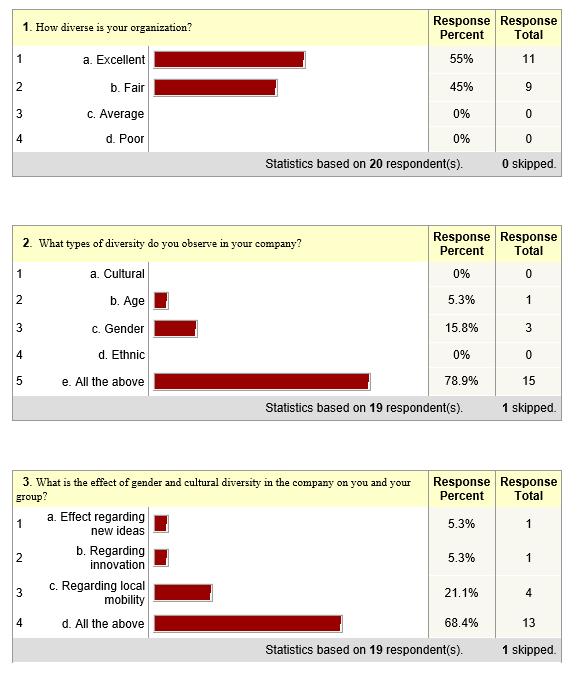





Report I
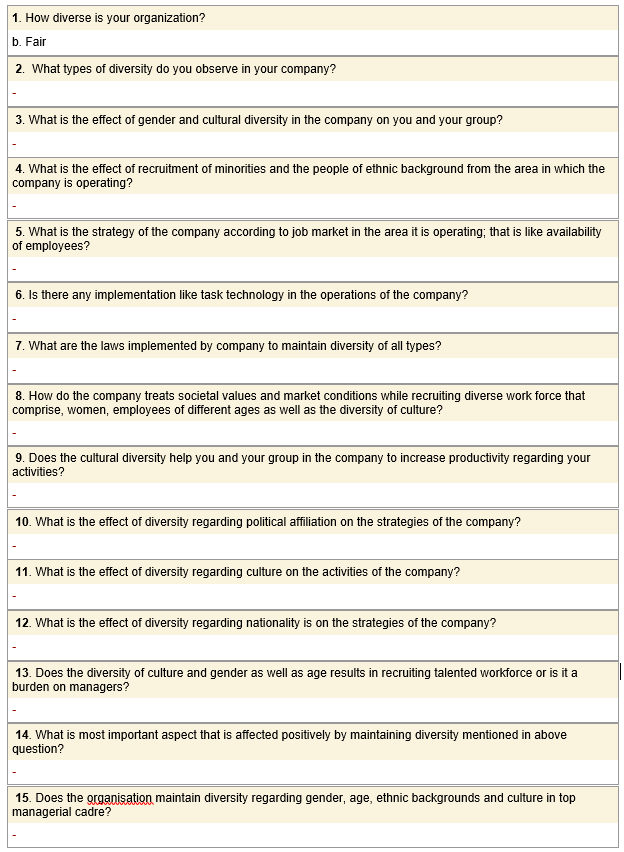

Report II
Strategic Human Resource Questionnaire on Shell Oil


Report 3
Strategic Human Resource Questionnaire on Shell Oil

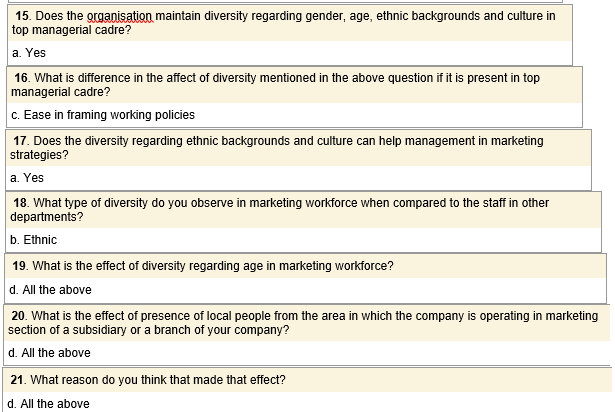
Report 4
Strategic Human Resource Questionnaire on Shell Oil
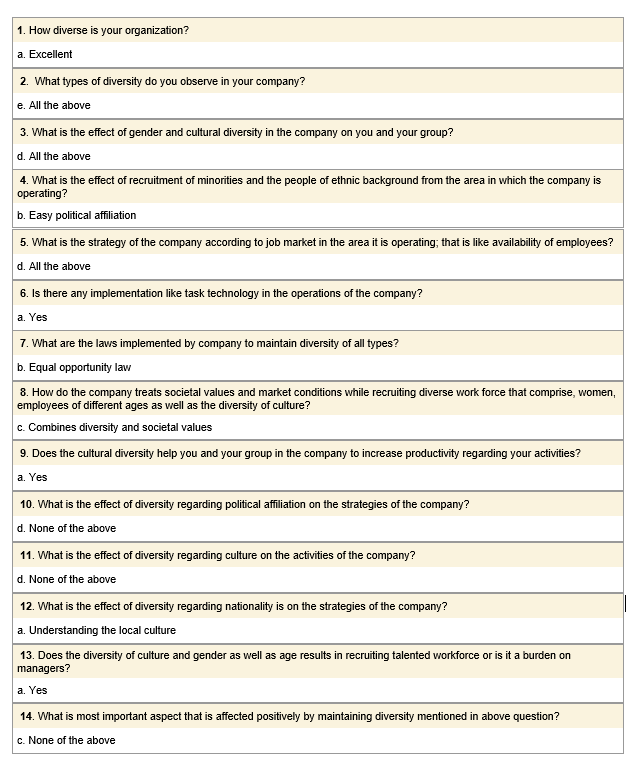

Report 5
Strategic Human Resource Questionnaire on Shell Oil

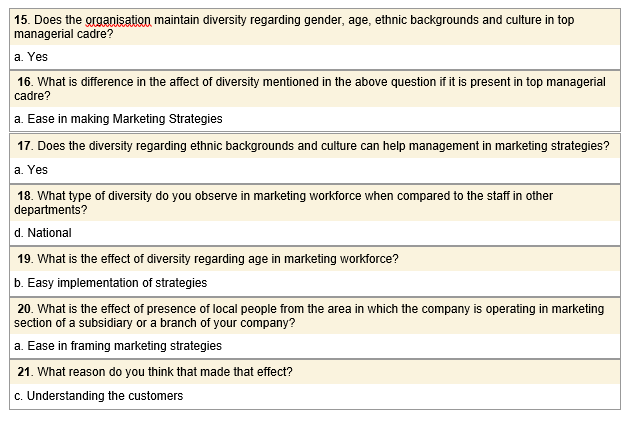
Report 6
Strategic Human Resource Questionnaire on Shell Oil
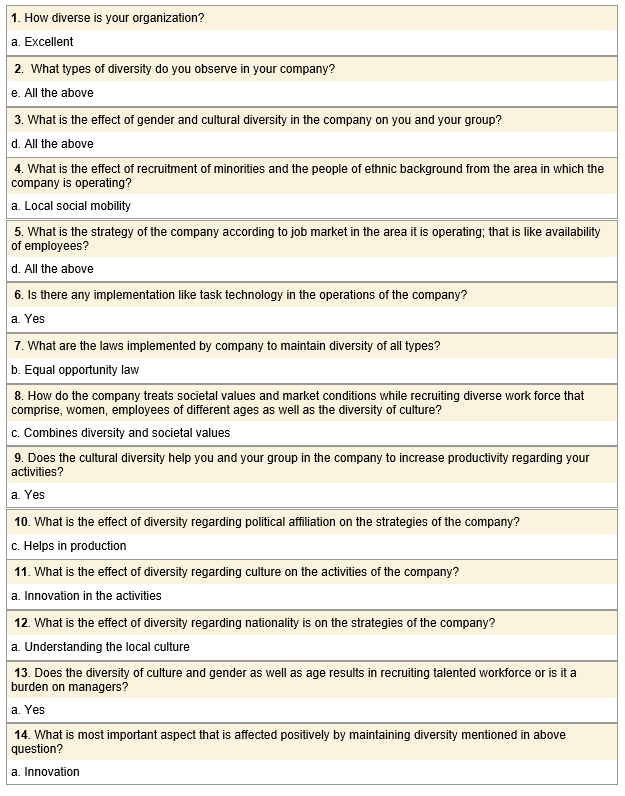

Report 7
Strategic Human Resource Questionnaire on Shell Oil
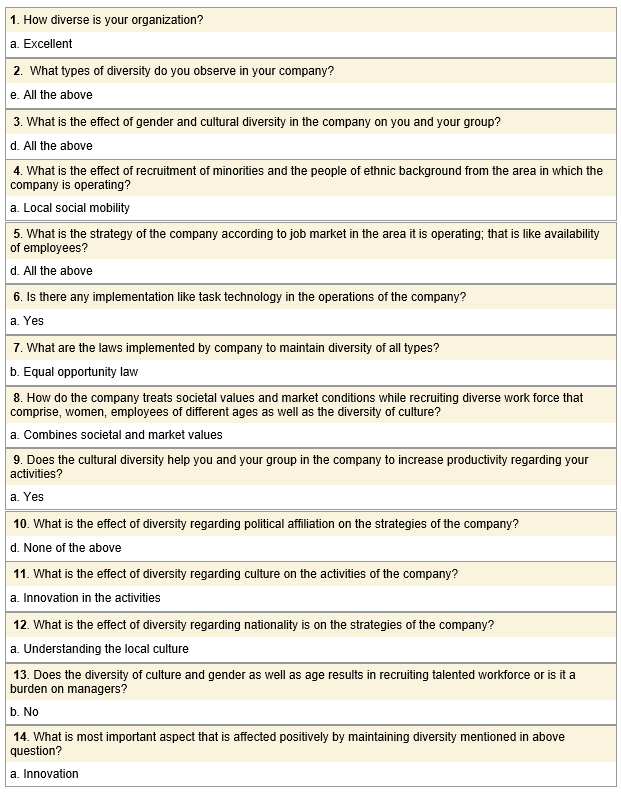
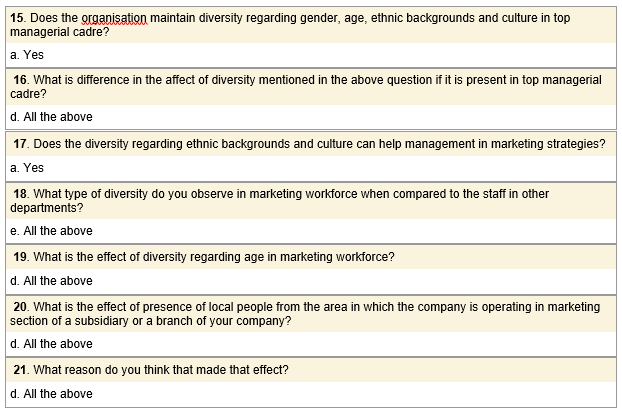
Report 8
Strategic Human Resource Questionnaire on Shell Oil
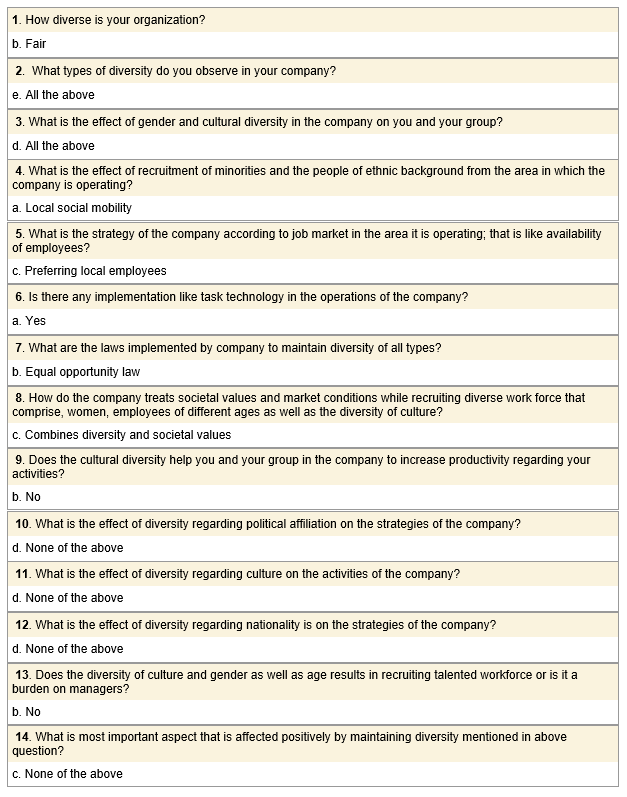
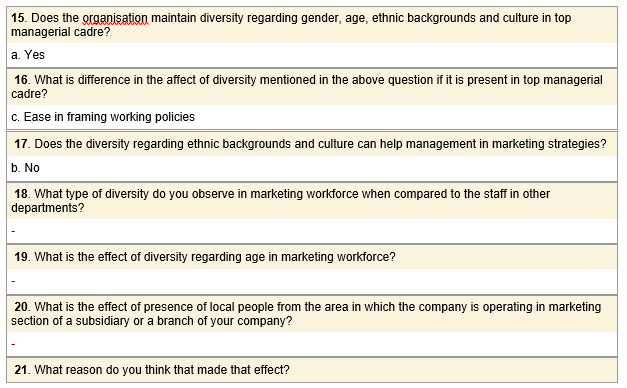
Report 9
Strategic Human Resource Questionnaire on Shell Oil
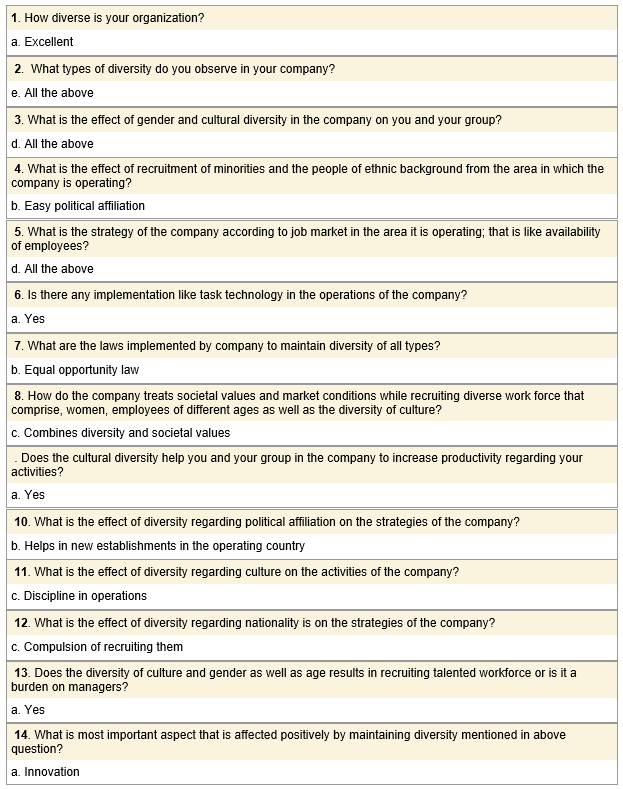
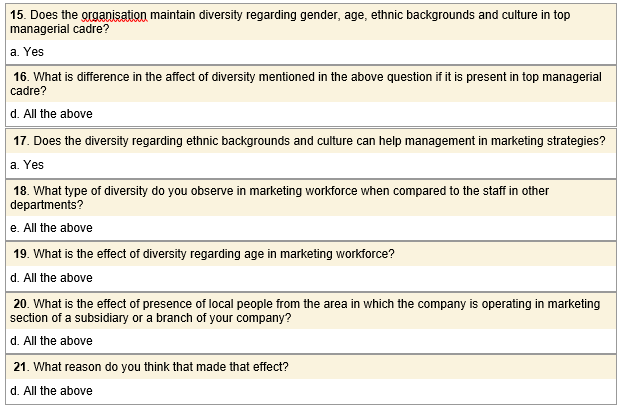
Report 10
Strategic Human Resource Questionnaire on Shell Oil

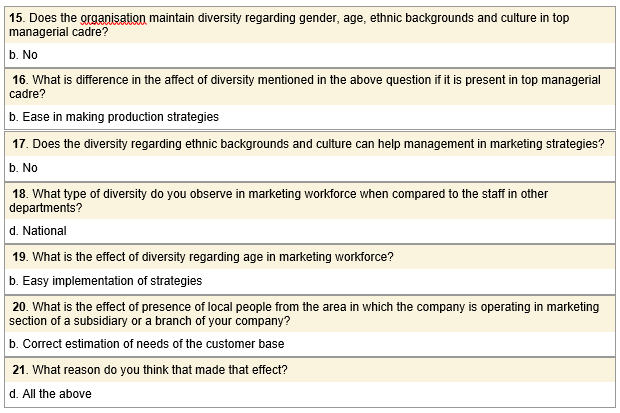
Report 11
Strategic Human Resource Questionnaire on Shell Oil
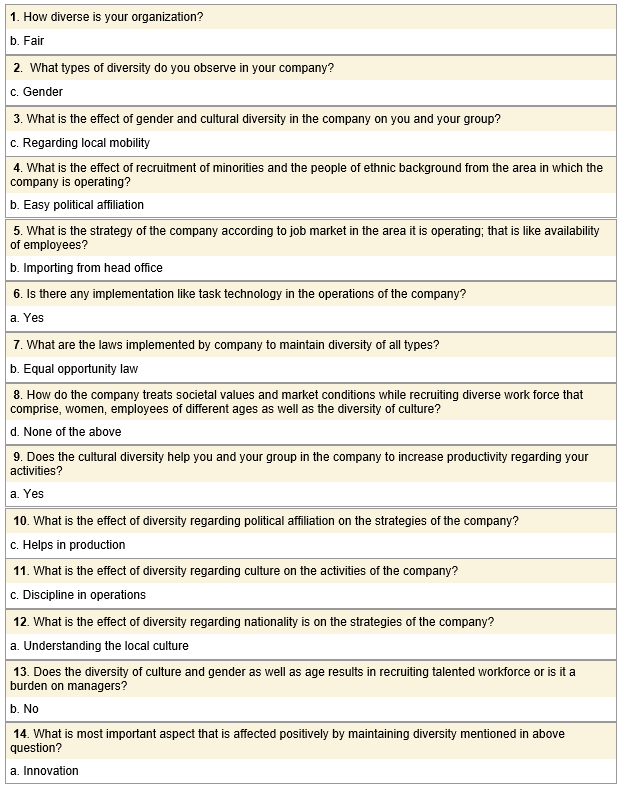

Report 12
Strategic Human Resource Questionnaire on Shell Oil
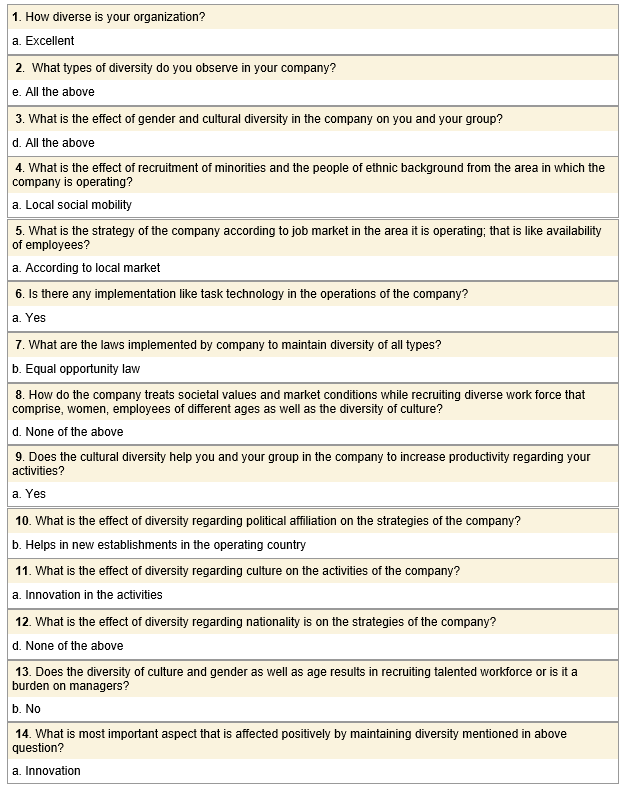
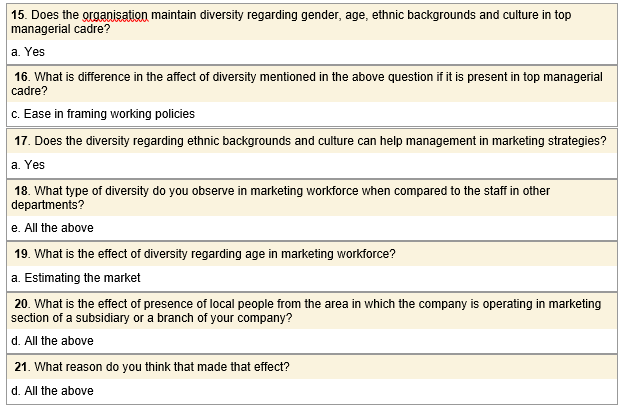
Report 13
Strategic Human Resource Questionnaire on Shell Oil
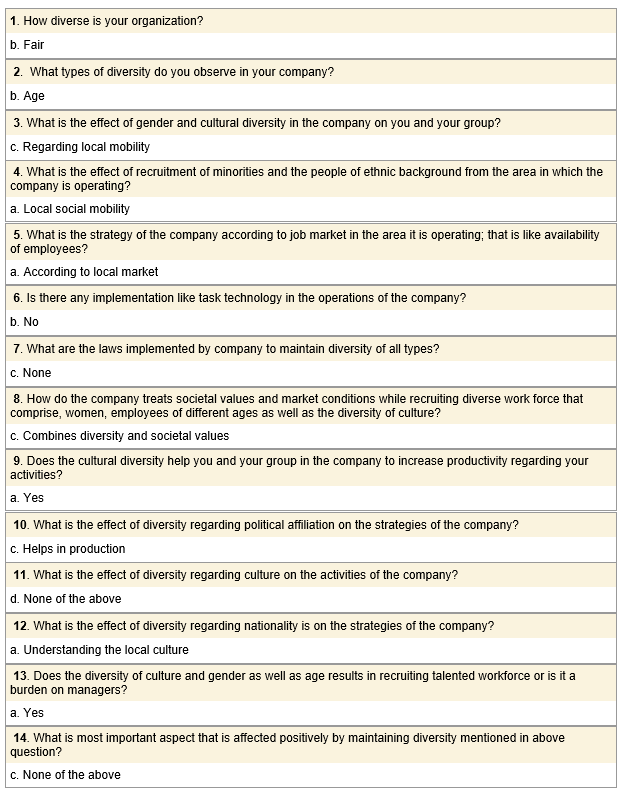
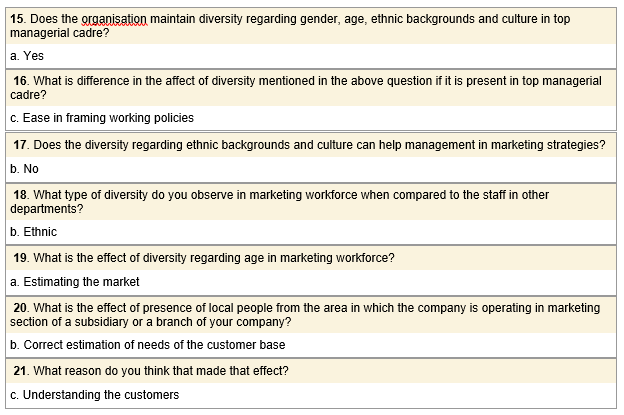
Report 14
Strategic Human Resource Questionnaire on Shell Oil
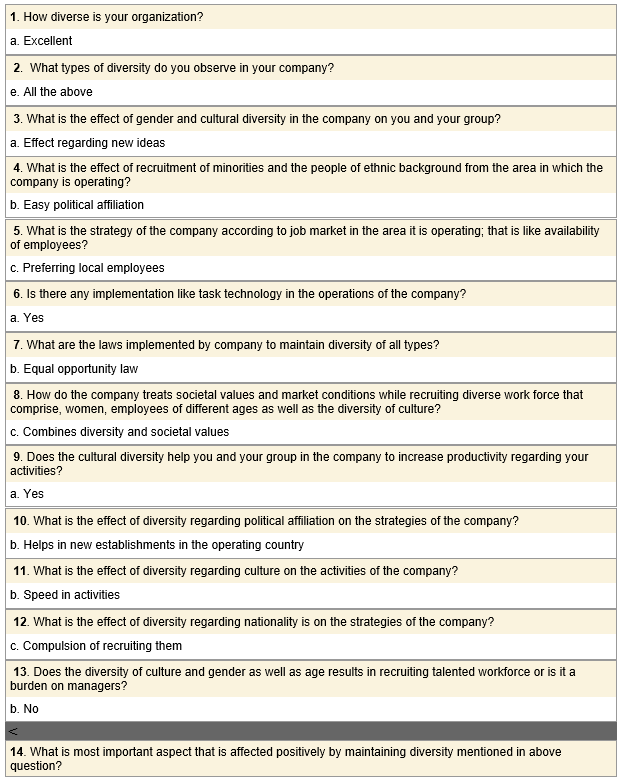
Report 15
Strategic Human Resource Questionnaire on Shell Oil
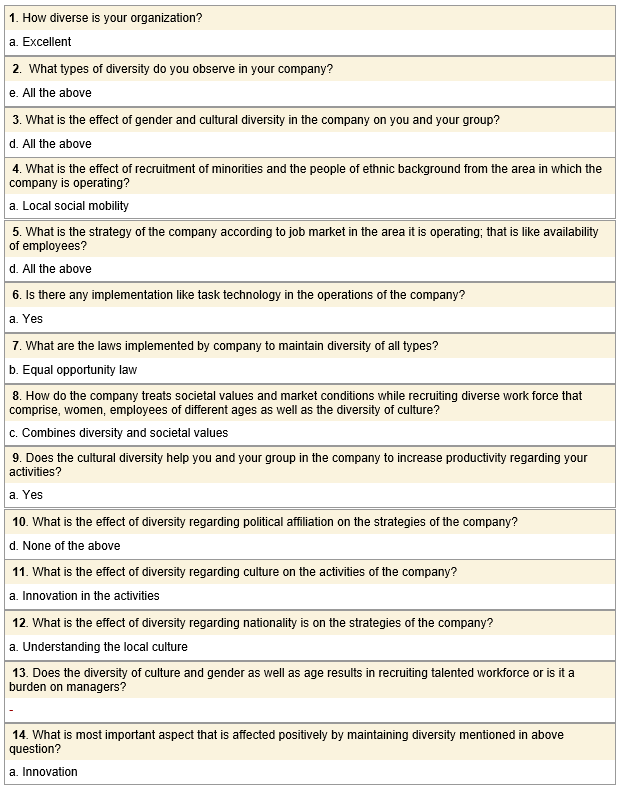
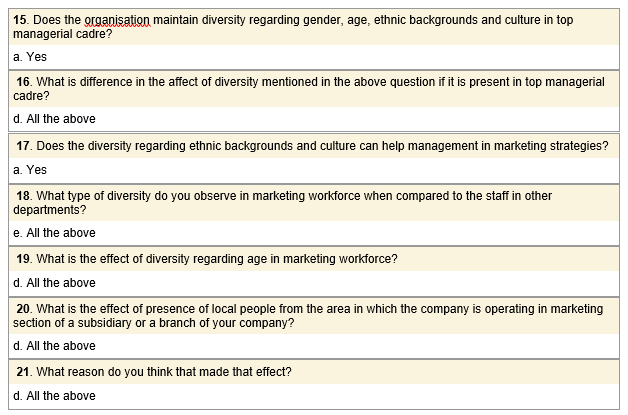
Report 16
Strategic Human Resource Questionnaire on Shell Oil
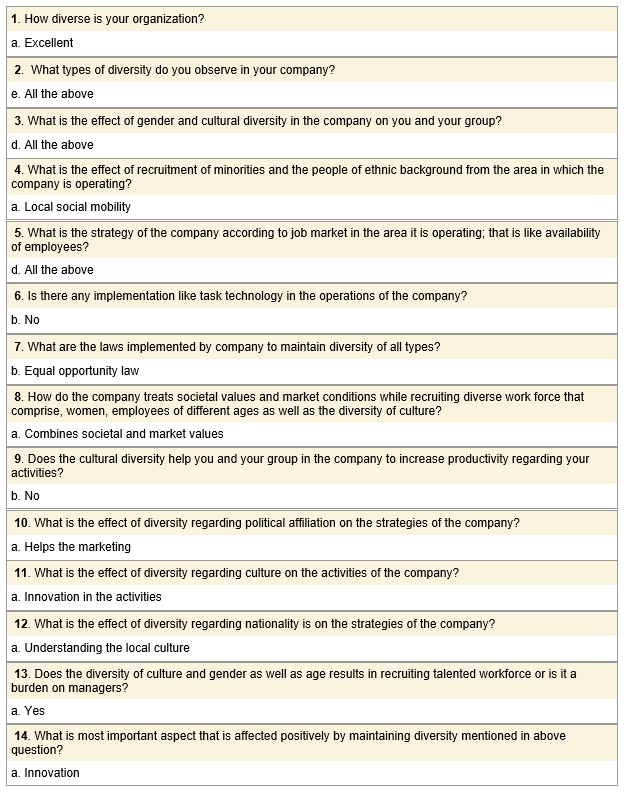
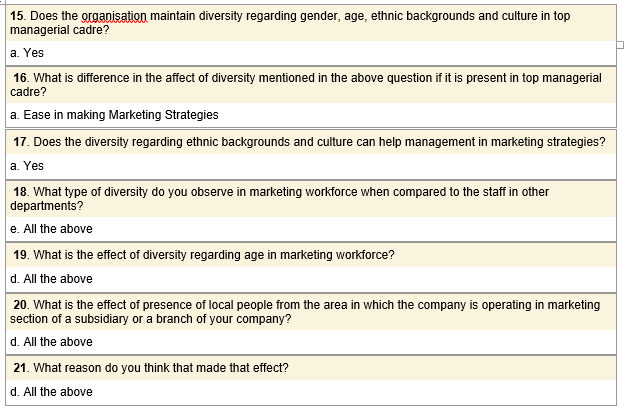
Report 17
Strategic Human Resource Questionnaire on Shell Oil
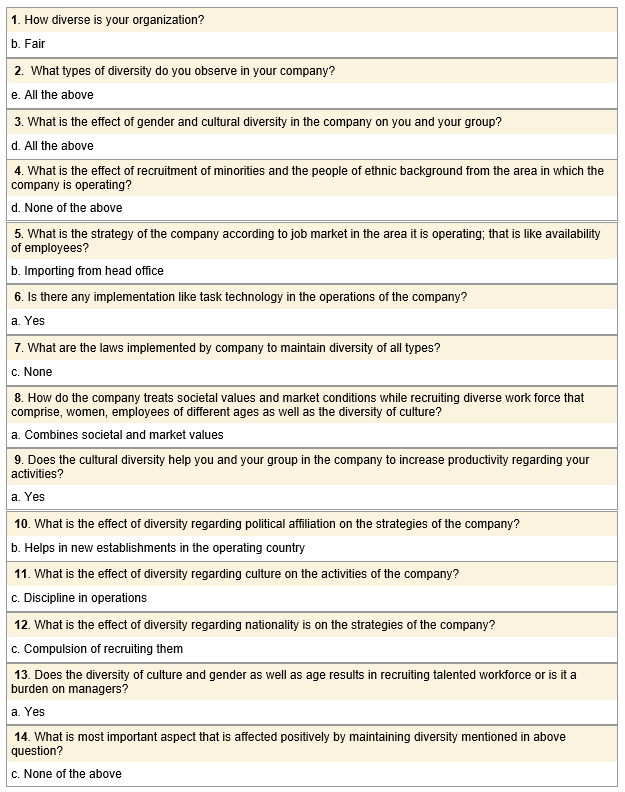
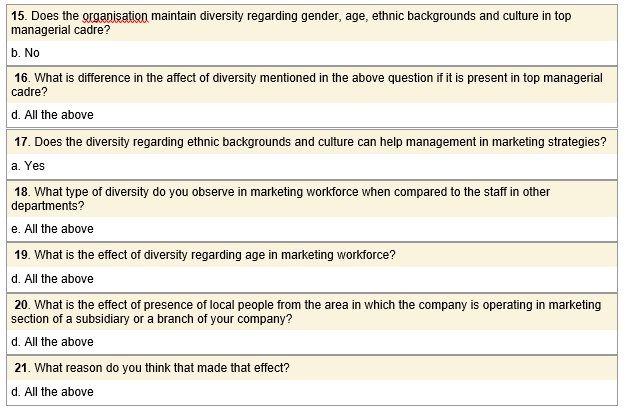
Report 18
Strategic Human Resource Questionnaire on Shell Oil
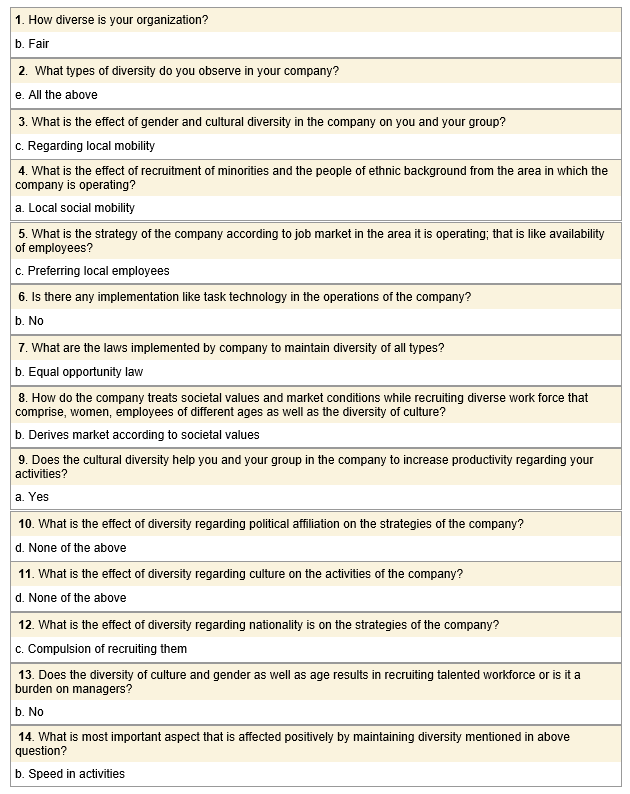
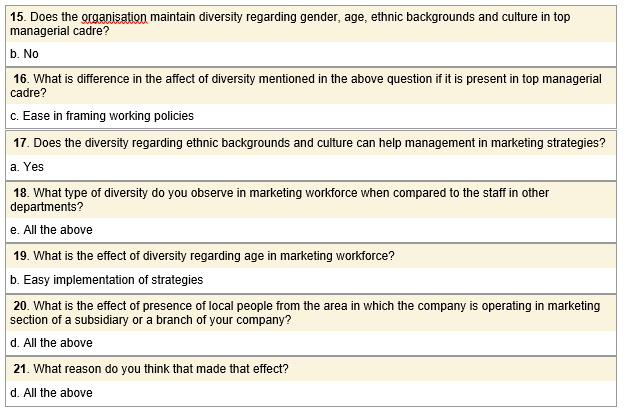
Report 19
Strategic Human Resource Questionnaire on Shell Oil
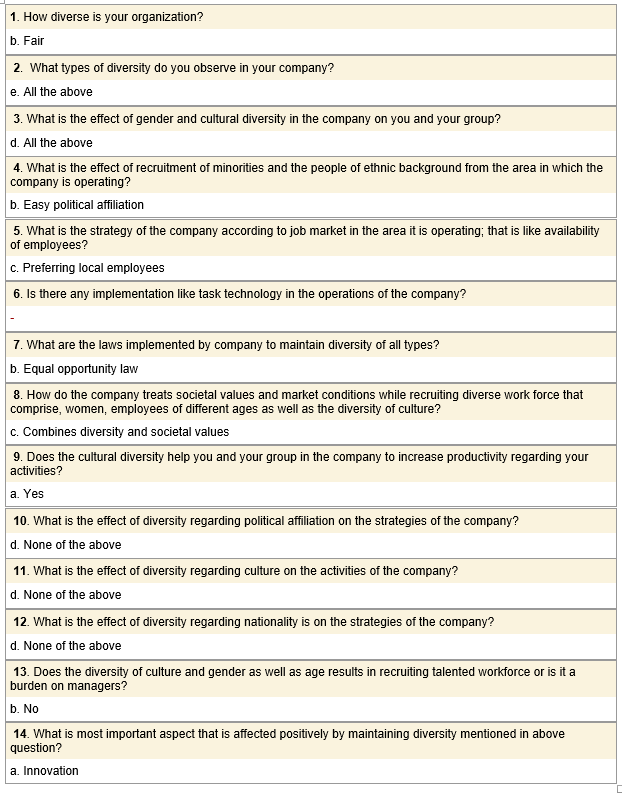
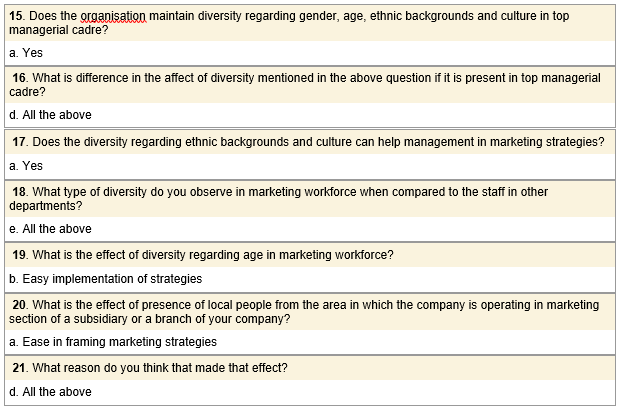
Report 20
Strategic Human Resource Questionnaire on Shell Oil
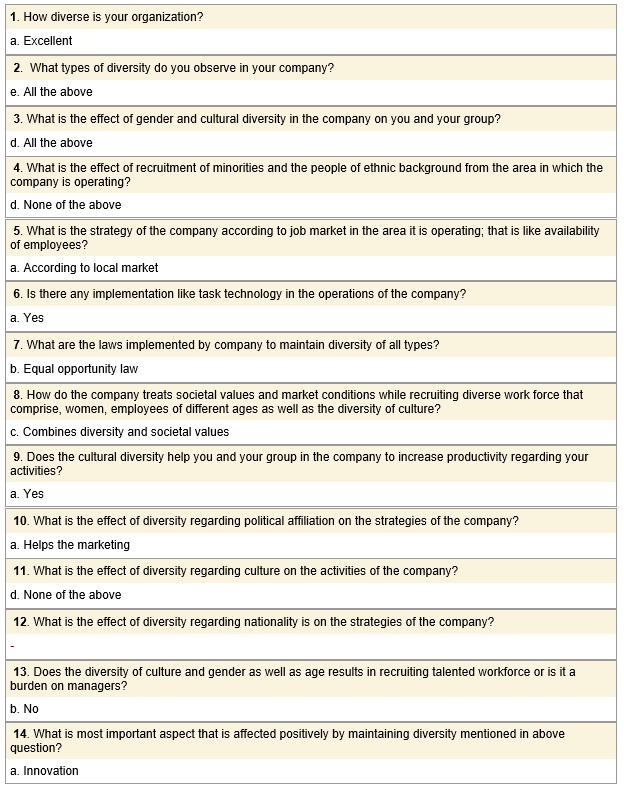
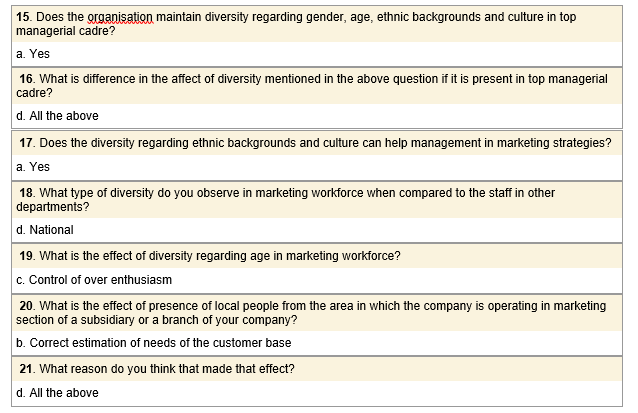
Footnotes
- Chittipa Ngamkroeckjoti, Lalit M. Johri, 2000, Management of Environmental Scanning Process in Large Companies in Thailand, Volume 6, Issue 4, Page 331. Emerald: UK, [2009].
- SPL, 2008, Sustainable Strategies. Web.
- SPL, 2008, Innovative Ways With Waste. Web.
- Shell Nigeria, 2008, Adding Value through Micro Credit. Web.
- Jeroen Van der Veer, 2007, Sustainable Development and our Business Strategy, Interview by [Aron Cramer], Holland. In Shell Sustainability Report 2007. Web.
- Rob Routs, 2007, Finding Energy in Diversity, Speech Delivered for European Petro Chemical Association, 2007 at EPCA Annual Meeting.
- Rob Routs, 2007, Finding Energy in Diversity, Speech Delivered for European Petro Chemical Association, 2007 at EPCA Annual Meeting.
- Adrian Loader, 2004, Putting Principles Into Practice, Lecture Delivered in a Seminar 2004 at Singapore/UK: Developing Social Responsibility Seminar.
- Jeremy Tipper, 2004, How to Increase 4 Through Your Recruitment Practices, Industrial and Commercial Training, Volume 36, Number 4, pp. 158-161.
- Armstrong, Michael (Author). 2006, Strategic Human Resource Management: A Guide to Action. London. GBR: Kogan Page Limited.
- The Richardson Company, 2002, Building the Virtual Team: Communication Across Cultural Diversity. Web.
- Alan Price, 2000, Principles of Human Resource Management, USA: Blackwell Business.
- Clare Lelliher, Michael Riley, 2002, Making functional flexibility stick: an assessment of the outcomes for stakeholders, International Journal of Contemporary Hospitality Management, 14, [5], 237-242.
- Samik Chatterjee, (2007), Case Study: Managing Diversity in the Training Room, Chetna Consultancy Services. Web.
- Patrick Schmidt, 2004, An Approach to Diversity Training in Canada, in Journal of Industrial and Commercial Training, 36 (2) 148-152.
- Wenchuan Liu, 2004, The Cross-National Transfer of HRM practices in MNCs: An Integrative Research Model, in International Journal of Manpower, 25 (6), 500 – 517.
- Sheila Jackson, Elaine Farndale and Andrew Kakabadse, 2003, Executive Development; Meeting the Needs of Top Teams and Boards, in Journal of Management Development, 22 (3) 185-265.
- Diversitycareers. 2009, At Shell Oil US; Inclusion Helps build a Better Business. Web.
- Barbara Myloni et al, 2004, Host Country Specific Factors and the Transfer of Human Resource Management Practices in Multinational Companies, in International Journal of Manpower, 25 (6) 518-534.
- Jennifer L. Gatewood, 2004, Fuelling Diversity. Web.
- Pollar, Odette (Author). 1994, Dynamics of Diversity: Strategic Programs for Your Organisation, Boston, MA. USA: Course Technology Crisp.
- Mc Guigan, Jim, 2004, Rethinking Cultural Policy, Berkshire, GBR: McGraw-Hill Education.
- WM.A.Wulf, 2002, The Importance of Diversity in Engineering, in ‘Diversity in Engineering: Managing the Work Force of the Future, Edited by National Academy of Engineering Staff, US: National Academy of Press.
- Gary Downey, 2002, Summary of Discussion on Topic Globalisation, in ‘Diversity in Engineering: Managing the work force of the Future, Edited by National Academy of Engineering Staff, US: National Academy of Press.
- Mining top News, 2008, Shell Oil Earns Top Marks in 2009 Corporate Index. Web.
- Report Summary in Appendices.
- Report Summary in Appendices.
- National Academy of Press (Staff), 2002, Diversity in Engineering: Managing the Work Force of the Future, Washington D.C, US: National Academy of Press.
- Report Summary in Appendices.
- Report Summary in Appendices.
- Pollitt, David 2006, Diversity in the Workforce. Bradford, GBR: Emerald Group Publishing Limited.
- Report Summary in Appendices.
- Shell Chemicals, 2008, Sustainable Strategies. Web.
- Report Summary in Appendices.
- Vikram Kumar, 2009, Shell Oil Jobs Loss and Impact on the Employees. Web.
- Shell Global Solutions, 2005, Field ware Technology Helps Optimize Production for Shell Gabon. Web.
- Dale L. Goodhue and Ronald L. Thompson, 2009, Task Technology Fit and Individual Performance, Amisq Archivist, 19 (2). Web.
- Report Summary in Appendices.
- Shell. 2009, Diversity and Inclusiveness. Web.
- Report Summary in Appendices.
- Taylor Cox, 2009, Workforce Diversity and Organisational Performance. Web.
- Amin Rajan, 2006, Promotion of Workforce Diversity, [Interview by Sarah Powell].
- Report Summary in Appendices.
- Mike Richardson et al., 2006, Best Value and Workplace Partnership in Local Government, in ‘Employment Relations and Public Services’, Edited by Bach, Stephen, UK: Emerald Group Publishing Limited.
- Report Summary in Appendices.
- Adam Dodson, 2004, Globalising GIS in Shell, Proceedings. [Online] London, Shell. Web.
- Report Summary in Appendices.
- Pollar, Odette, 1994, Dynamics of Diversity: Strategic Programs for your Organisation, Boston, MA. USA: Course Technology Crisp.
- Report Summary in Appendices.
- Marquis, Jefferson P, 2007, Managing Diversity in Corporate America: An Exploratory Analysis. Santa Monica, CA, USA: Rand Corporation.
- Shell. (2009) Welcome to Shell India’s Lubricants Division. Web.
- Report Summary in Appendices.
- Shell.(2009), Shell Ranks in Div50 for Diversity. Web.
- Harry G. Barkema, 2006, Does Top Management Team Diversity Promote or Hamper Foreign Expansion? Web.
- Report Summary in Appendices.
- The Free Library, 2004, Shell Oil Products US: Reaches out to Minority Audiences. Web.
- Kermally, Sultan, 2004, Gurus on Marketing. London, GBR: Thorogood.
- Report Summary in Appendices.
- Shell. 2009, Royal Dutch Shell Plc announces new Senior Management Structure. Web.
- Shell. 2009, Buying and Hiring Locally. Web.
- Jeroen Van der Veer, 2008, Exploring Reasons for Strategic Change. Web.